
- 1 -
REV. 0.6 Oct. 21. 2002
128Mb D-die(x16) DDR SDRAM
DDR SDRAM Specification
Version 0.6

- 2 -
REV. 0.6 Oct. 21. 2002
128Mb D-die(x16) DDR SDRAM
Revision History
Version 0 (July, 2001)
- First version for internal review
Version 0.1 (September, 2001)
- Changed spec to preliminary version
Version 0.2(October,2001)
- Changed final spec from preliminary spec.
- Modificated typo.
- Changed pin # 17 from NC to A13 in Package pinout.
- Revised "Write with autoprecharge" table in page 29.
- Added tIS and tPDEX parameters in "power down" timing of page 31.
- Revised "Absolute maximum rating" table in page 38.
. Changed "Voltage on VDDQ supply relative to VSS" value from -0.5~3.6V to -1~3.6V
. Changed "power dissipation" value from 1.0W to 1.5W.
- Revised AC parameter table
Version 0.3(November,2001)
- Deleted "preliminary"
-
Deleted tHZ/tLZ of DQS
Version 0.31(November,2001)
- Added DDR333 AC timing table
Version 0.4(November,2001)
- Deleted typical current in IDD spec. table
- Updated DDR333 test specification
- Deleted typical current in IDD spec. table
- Included address and control input setup/hold time(tIS/tIH) at slow slew rate in DDR200/266 AC specification
- Deleted Exit self refresh to write command(tXSW) in DDR200/266 AC specification
- Changed unit of tMRD from tCK to ns at DDR333
- Rename tXSA(exit self refresh to bank active command) to tXSNR(exit self refresh to non read command) at DDR200/266
- Rename tXSR(exit self refresh to read command) to tXSRD at DDR200/266
- Rename tWPREH(DQS in hold time) to tWPRE at DDR200/266
- Rename tREF(Refresh interval time) to tREFI at DDR200/266
- Added tDAL(tWR+tRP)
- Updated current value
From
To
DDR266A
DDR266B
DDR200
DDR266A
DDR266B
DDR200
Min.
Max.
Min.
Max.
Min.
Max.
Min.
Max.
Min.
Max.
Min.
Max.
tHZ(DQ)
tACmin
-400ps
tACmax
-400ps
tACmin
-400ps
tACmax
-400ps
tACmin
-400ps
tACmax
-400ps
-0.75
+0.75
-0.75
+0.75
-0.8
+0.8
tLZ(DQ)
tACmin
-400ps
tACmax
-400ps
tACmin
-400ps
tACmax
-400ps
tACmin
-400ps
tACmax
-400ps
-0.75
+0.75
-0.75
+0.75
-0.8
+0.8
tHZ(DQS)
-0.75
+0.75
-0.75
+0.75
-0.8
+0.8
tLZ(DQS)
-0.75
+0.75
-0.75
+0.75
-1.1
-0.8
tWPST
(tCK)
0.25
0.25
0.25
0.4
0.6
0.4
0.6
0.4
0.6
tPDEX
10ns
10ns
10ns
7.5ns
7.5ns
10ns

- 3 -
REV. 0.6 Oct. 21. 2002
128Mb D-die(x16) DDR SDRAM
Revision History
Version 0.5 (Jan, 2002)
- Added tRAP(Active to Read w/ Auto precharge command)
Version 0.6 (Oct, 2002)
- Modify DC current(IDD spec table)

- 4 -
REV. 0.6 Oct. 21. 2002
128Mb D-die(x16) DDR SDRAM
Contents
Revision History
General Information
1. Key Features
1.1 Features
1.2 Operating Frequencies
2. Package Pinout & Dimension
2.1 Package Pintout
2.2 Input/Output Function Description
2.3 66 Pin TSOP(II)/MS-024FC Package Physical Dimension
3. Functional Description
3.1 Simplified State Diagram
3.2 Basic Functionality
3.2.1 Power-Up Sequence
3.2.2 Mode Register Definition
3.2.2.1 Mode Register Set(MRS)
3.2.2.2 Extended Mode Register Set(EMRS)
3.2.3 Precharge
3.2.4 No Operation(NOP) & Device Deselect
3.2.5 Row Active
3.2.6 Read Bank
3.2.7 Write Bank
3.3 Essential Functionality for DDR SDRAM
3.3.1 Burst Read Operation
3.3.2 Burst Write Operation
3.3.3 Read Interrupted by a Read
3.3.4 Read Interrupted by a Write & Burst Stop
3.3.5 Read Interrupted by a Precharge
3.3.6 Write Interrupted by a Write

- 5 -
REV. 0.6 Oct. 21. 2002
128Mb D-die(x16) DDR SDRAM
3.3.7 Write Interrupted by a Read & DM
3.3.8 Write Interrupted by a Precharge & DM
3.3.9 Burst Stop
3.3.10 DM masking
3.3.11 Read With Auto Precharge
3.3.12 Write With Auto Precharge
3.3.13 Auto Refresh & Self Refresh
3.3.14 Power Down
4. Command Truth Table
5. Functional Truth Table
6. Absolute Maximum Rating
7. DC Operating Conditions & Specifications
7.1 DC Operating Conditions
7.2 DC Specifications
8. AC Operating Conditions & Timming Specification
8.1 AC Operating Conditions
8.2 AC Overshoot/Undershoot specification
8.1.1 Overshoot/Undershoot specification for Address and Control Pins
8.1.2 Overshoot/Undershoot specification for Data Pins
8.3 AC Timming Parameters & Specification
9. AC Operating Test Conditions
10. Input/Output Capacitance
11. IBIS: I/V Characteristics for Input and Output Buffers
11.1 Normal strength driver
11.2 Half strength driver
Timing Diagram

- 6 -
REV. 0.6 Oct. 21. 2002
128Mb D-die(x16) DDR SDRAM
Table 1 : Operating frequency and DLL jitter
Table 2. : Column address configurtion
Table 3 : Input/Output function description
Table 4 : Burst address ordering for burst length
Table 5 : Bank selection for precharge by bank address bits
Table 6 : Operating description when new command asserted while
read with auto precharge is issued
Table 7 : Operating description when new command asserted while
write with auto precharge is issued
Table 8 : Command truth table
Table 9-1 : Functional truth table
Table 9-2 : Functional truth table (contiued)
Table 9-3 : Functional truth table (contiued)
Table 9-4 : Functional truth table (contiued)
Table 9-5 : Functional truth table (cotinued)
Table 10 : Absolute maximum raings
Table 11 : DC operating condtion
Table 12 : DC specification
Table 13 : AC operating condition
Table 14 : Overshoot/Undershoot specification for Address and Control Pins
Table 15 : Overshoot/Undershoot specification for Data Pins
Table 16 : AC timing parameters and specifications
Table 17 : AC operating test conditions
Table 18 : Input/Output capacitance
Table 19 : Pull down and pull up current values(For normal strength driver)
Table 20 : Pull down and pull up current values(For half strength driver)
List of tables

- 7 -
REV. 0.6 Oct. 21. 2002
128Mb D-die(x16) DDR SDRAM
Figure 1 : 128Mb Package Pinout
Figure 2 : Package dimension
Figure 3 : State digram
Figure 4 : Power up and initialization sequence
Figure 5 : Mode register set
Figure 6 : Mode register set sequence
Figure 7 : Extend mode register set
Figure 8 : Bank activation command cycle timing
Figure 9 : Burst read operation timing
Figure 10 : Burst write operation timing
Figure 11 : Read interrupted by a read timing
Figure 12 : Read interrupted by a write and burst stop timing
Figure 13 : Read interrupted by a precharge timing
Figure 14 : Write interrupted by a write timing
Figure 15 : Write interrupted by a read and DM timing
Figure 16 : Write interrupted by a precharge and DM timing
Figure 17 : Burst stop timing
Figure 18 : DM masking timing
Figure 19 : Read with auto precharge timing
Figure 20 : Write with auto precharge timing
Figure 21 : Auto refresh timing
Figure 22 : Self refresh timing
Figure 23 : Power down entry and exit timing
Figure 24 : AC overshoot/Undershoot Definition
Figure 25 : AC overshoot/Undershoot Definition
Figure 26 : Output Load Circuit (SSTL_2)
Figure 27 : I / V characteristics for input/output buffers(For normal strength driver):
pull-up(above) and pull-down(below)
Figure 28 : I / V characteristics for input/output buffers(For half strength driver):
pull-up(above) and pull-down(below)
List of figures

- 8 -
REV. 0.6 Oct. 21. 2002
128Mb D-die(x16) DDR SDRAM
General Information
Organization
166Mhz/ CL=2.5
133Mhz w/ CL=2
133Mhz w/ CL=2.5
100Mhz w/ CL=2
8Mx16
K4H281638D-TCB3
K4H281638D-TCA2
K4H281638D-TCB0
K4H281638D-TCA0
K4H281638D-TLB3
K4H281638D-TLA2
K4H281638D-TLB0
K4H281638D-TLA0
T
: TSOP2 (400mil x 875mil)
A0
: 10ns@CL2
A2
: 7.5ns@CL2
B0
: 7.5ns@CL2.5
B3 : 6ns@CL2.5
C : (Commercial, Normal)
L : (Commercial, Low)
04
: x4
08
: x8
16
: x16
32
: x32
64
: 64M 4K/64ms
28
: 128M 4K/64ms
56
: 256M 8K/64ms
51
: 512M 8K/64ms
1G
: 1G 16K/32ms
H
: DDR SDRAM
M
: 1st Generation
A
: 2nd Generation
B
: 3rd Generation
C
: 4th Generation
D
: 5th Generation
E
: 6th Generation
K 4 H XX XX X X X - X X
Memory
DRAM
Small Classification
Density and Refresh
Temperature & Power
Package
Organization
Version
Interface (VDD & VDDQ)
1. SAMSUNG Memory : K
2. DRAM : 4
3. Small Classification
4. Density & Refresh
5. Organization
8. Version
9. Package
10. Temperature & Power
11. Speed
3
: 4 Bank
6. Bank
1 2 3 4 5 6 7 8 9 10 11
XX
8
: SSTL-2(2.5V, 2.5V)
7. Interface (VDD & VDDQ)
Speed
Bank

- 9 -
REV. 0.6 Oct. 21. 2002
128Mb D-die(x16) DDR SDRAM
� Double-data-rate architecture; two data transfers per clock cycle
� Bidirectional data strobe(DQS)
� Four banks operation
� Differential clock inputs(CK and CK)
� DLL aligns DQ and DQS transition with CK transition
� MRS cycle with address key programs
-. Read latency 2, 2.5 (clock)
-. Burst length (2, 4, 8)
-. Burst type (sequential & interleave)
� All inputs except data & DM are sampled at the positive going edge of the system clock(CK)
� Data I/O transactions on both edges of data strobe
� Edge aligned data output, center aligned data input
� LDM,UDM/DM for write masking only
� Auto & Self refresh
� 15.6us refresh interval(4K/64ms refresh)
� Maximum burst refresh cycle : 8
� 66pin TSOP II package
1. Key Features
1.1 Features
1.2 Operating Frequencies
*CL : Cas Latency
Table 1. Operating frequency and DLL jitter
-B3(DDR333)
- A2(DDR266A)
- B0(DDR266B)
- A0(DDR200)
Speed @CL2
133Mhz
133MHz
100MHz
100MHz
Speed @CL2.5
166Mhz
133MHz
133MHz
-
DLL jitter
�0.7ns
�0.75ns
�0.75ns
�0.8ns

- 10 -
REV. 0.6 Oct. 21. 2002
128Mb D-die(x16) DDR SDRAM
1
66 PIN TSOP(II)
(400mil x 875mil)
2
3
4
5
6
7
8
9
10
11
12
20
19
18
17
16
15
14
13
27
26
25
24
23
22
21
54
53
52
51
50
49
48
47
46
45
44
43
35
36
37
38
39
40
41
42
55
56
57
58
59
60
34
(0.65 mm PIN PITCH)
33
32
31
30
29
28
61
62
63
64
65
66
Bank Address
BA0-BA1
Row Address
A0-A11
Auto Precharge
A10
MS-024FC
Organization
Column Address
8Mx16
A0-A8
DM is internally loaded to match DQ and DQS identically.
2.1 Package Pinout
FIgure 1. package Pinout
Table 2. Column address configuration
2. Package Pinout & Dimension
V
DD
DQ
0
V
D D Q
DQ
1
DQ
2
V
S S Q
DQ
3
DQ
4
V
D D Q
DQ
5
DQ
6
V
S S Q
BA
0
C S
RAS
CAS
WE
LDM
V
D D Q
DQ
7
V
DD
A
3
A
2
A
1
A
0
AP/A
1 0
BA
1
NC
LDQS
NC
NC
NC
V
DD
V
S S
DQ
1 5
V
S S Q
DQ
1 4
DQ
1 3
V
DDQ
DQ
1 2
DQ
1 1
V
S S Q
DQ
1 0
DQ
9
V
DDQ
A
1 1
CKE
CK
UDM
V
R E F
V
S S Q
DQ
8
V
S S
A
4
A
5
A
6
A
7
A
8
A
9
NC
UDQS
NC
V
S S
CK
NC
NC
8Mb x 16

- 11 -
REV. 0.6 Oct. 21. 2002
128Mb D-die(x16) DDR SDRAM
2.2 Input/Output Function Description
Table 3. Input/Output Function Description
SYMBOL
TYPE
DESCRIPTION
CK, CK
Input
Clock : CK and CK are differential clock inputs. All address and control input signals are sam-
pled on the positive edge of CK and negative edge of CK . Output (read) data is referenced to
both edges of CK. Internal clock signals are derived from CK/CK.
CKE
Input
Clock Enable : CKE HIGH activates, and CKE LOW deactivates internal clock signals, and
device input buffers and output drivers. Deactivating the clock provides PRECHARGE
POWER-DOWN and SELF REFRESH operation (all banks idle), or ACTIVE POWER-DOWN
(row ACTIVE in any bank). CKE is synchronous for all functions except for disabling outputs,
which is achieved asynchronously. Input buffers, excluding CK, CK and CKE are disabled
during power-down and self refresh modes, providing low standby power. CKE will recognize
an LVCMOS LOW level prior to VREF being stable on power-up.
CS
Input
Chip Select : CS enables(registered LOW) and disables(registered HIGH) the command
decoder. All commands are masked when CS is registered HIGH. CS provides for external
bank selection on systems with multiple banks. CS is considered part of the command code.
RAS, CAS, WE
Input
Command Inputs : RAS , CAS and WE (along with CS) define the command being entered.
*1
LDM,(U)DM
Input
Input Data Mask : DM is an input mask signal for write data. Input data is masked when DM is
sampled HIGH along with that input data during a WRITE access. DM is sampled on both
edges of DQS. DM pins include dummy loading internally, to matches the DQ and DQS load-
ing. For the x16, LDM corresponds to the data on DQ0-DQ7 ; UDM correspons to the data on
DQ8-DQ15.
BA0, BA1
Input
Bank Addres Inputs : BA0 and BA1 define to which bank an ACTIVE, READ, WRITE or PRE-
CHARGE command is being applied.
A [n : 0]
Input
Address Inputs : Provide the row address for ACTIVE commands, and the column address
and AUTO PRECHARGE bit for READ/WRITE commands, to select one location out of the
memory array in the respective bank. A10 is sampled during a PRECHARGE command to
determine whether the PRECHARGE applies to one bank (A10 LOW) or all banks (A10
HIGH). If only one bank is to be precharged, the bank is selected by BA0, BA1. The address
inputs also provide the op-code during a MODE REGISTER SET command. BA0 and BA1
define which mode register is loaded during the MODE REGISTER SET command (MRS or
EMRS).
*1
DQ
I/O
Data Input/Output : Data bus
*1
LDQS,(U)DQS
I/O
Data Strobe : Output with read data, input with write data. Edge-aligned with read data, cen-
tered in write data. Used to capture write data. For the x16, LDQS corresponds to the data on
DQ0-DQ7 ; UDQS corresponds to the data on DQ8-DQ15.
NC
-
No Connect : No internal electrical connection is present.
V
DD
Q
Supply
DQ Power Supply : +2.5V
�
0.2V.
V
SS
Q
Supply
DQ Ground.
V
DD
Supply
Power Supply : +2.5V
�
0.2V (device specific).
V
SS
Supply
Ground.
V
REF
Input
SSTL_2 reference voltage.
*1 : DQ, DQS, DM signals may be floated to V
TT
when no data is being transfened.

- 12 -
REV. 0.6 Oct. 21. 2002
128Mb D-die(x16) DDR SDRAM
Units : Millimeters
0.30
�
0.08
0.65TYP
(0.71)
22.22
�
0.10
0.125
(
0
.
8
0
)
1
0
.
1
6
�
0
.
1
0
0
�
~8
�
#1
#33
#66
#34
(1.50)
(
1
.
5
0
)
0.65
�
0.08
1
.
0
0
�
0
.
1
0
1
.
2
0
M
A
X
(
0
.
5
0
)
(
0
.
5
0
)
(
1
0
.
7
6
)
1
1
.
7
6
�
0
.
2
0
(10
�
)
(10
�
)
+ 0 . 0 7 5
- 0 . 0 3 5
(
0
.
8
0
)
0.10 MAX
0.075 MAX
[
]
0
.
0
5
M
I
N
(10
�
)
(10
�
)
(R0.1
5)
0
.
2
1
0
�
0
.
0
5
0
.
6
6
5
�
0
.
0
5
(R
0.
15
)
(4
�
)
(R
0.
25
)
(R
0.2
5)
0
.
4
5
~
0
.
7
5
0.25TYP
NOTE
1. ( ) IS REFERENCE
2. [ ] IS ASS
'
Y OUT QUALITY
2.3 66pin TSOP-II Package Dimension
FIgure 2. package Dimension

- 13 -
REV. 0.6 Oct. 21. 2002
128Mb D-die(x16) DDR SDRAM
3. Functional Description
3.1 Simplified State Diagram
READ
SELF
REFRESH
AUTO
REFRESH
POWER
DOWN
ROW
ACTIVE
READA
WRITEA
WRITEA
PRE
CHARGE
POWER
ON
IDLE
MODE
POWER
DOWN
REGISTER
SET
REFS
REFSX
REFA
MRS
CKEL
CKEH
ACT
CKEH
CKE L
WRITE
WRITE
WRITEA
PRE
PRE
POWER
APPLIED
READA
PRE
PRE
READA
WRITEA
READA
READ
READ
Automatic Sequence
Command Sequence
BURST STOP
WRITEA : Write with autoprecharge
READA : Read with autoprecharge
Figure 3. State diagram
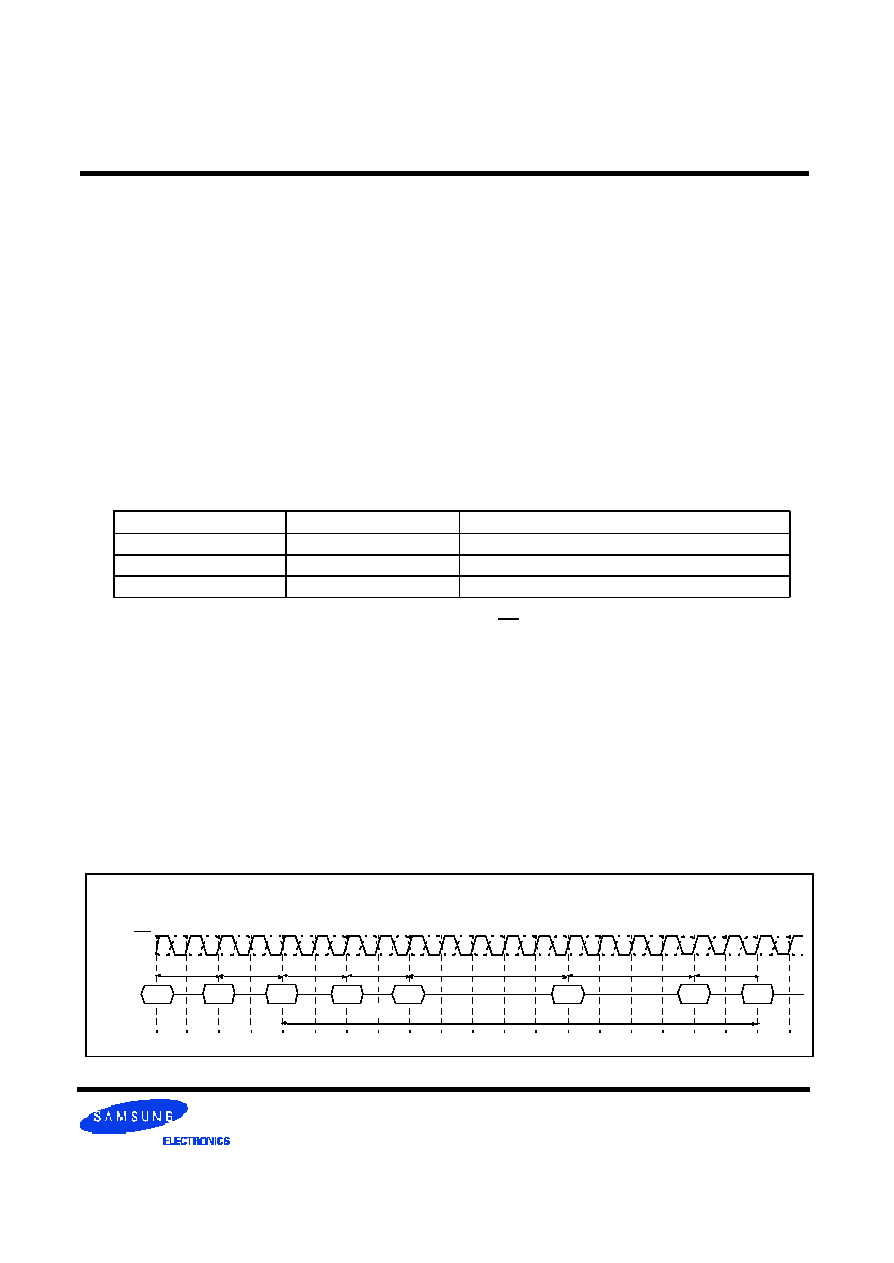
- 14 -
REV. 0.6 Oct. 21. 2002
128Mb D-die(x16) DDR SDRAM
3.2.1 Power-Up and Initialization Sequence
The following sequence is required for POWER UP and Initialization.
1. Apply power and attempt to maintain CKE at a low state(all other inputs may be undefined.)
- Apply V
DD
before or at the same time as V
DD
Q.
- Apply V
DD
Q before or at the same time as V
TT
& Vref.
No power sequencing is specified during power up or power down given the following criteria:
�
V
DD
and V
DD
Q are driven from a single power converter output, and
�
V
TT
is limited to 1.44V (reflecting V
DD
Q(max)/2 + 50mV V
REF
variation +40m V V
TT
variation), and
�
V
REF
tracks V
DD
Q/2, and
� A minimum resistance of 42 ohms(22 ohm series resistor + 22 ohm parallel resistor 5% tolerance)
limits the input current from the V
TT
supply into any pin.
If the above criteria cannot be met by the system design, the following table must be adhered
to during power up:
2. Start clock and maintain stable condition for a minimum of 200us.
3. The minimum of 200us after stable power and clock(CK, CK), apply NOP & take CKE high.
4. Issue precharge commands for all banks of the device.
5. Issue EMRS to enable DLL.(To issue "DLL Enable" command, provide "Low" to A0, "High" to BA0 and
"Low" to all of the rest address pins, A1~A11 and BA1)
6. Issue a mode register set command for "DLL reset". The additional 200 cycles of clock input is required
to lock the DLL. (To issue DLL reset command, provide "High" to A8 and "Low" to BA0)
*1
7. Issue precharge commands for all banks of the device.
8. Issue 2 or more auto-refresh commands.
9. Issue a mode register set command with low to A8 to initialize device operation.
*1 Sequence of 6 & 7 is regardless of the order.
Voltage Description
Sequencing
Voltage Relationship to avoid latch-up
VDDQ
After or with VDD
<VDD + 0.3V
VTT
After or with VDDQ
< VDDQ +0.3V
VREF
After or with VDDQ
<VDDQ +0.3V
Power up & Initialization Sequence
Command
0
1
2
3
4
5
6
7
8
9
10
11
12
13
14
15
16
17
18
19
t
R P
2 Clock min.
precharge
ALL Banks
2nd Auto
Refresh
M o d e
Register Set
Any
Command
t
RFC
1st Auto
Refresh
t
RFC
min.200 Cycle
E M R S
MRS
2 Clock min.
DLL Reset
2 Clock min.
precharge
ALL Banks
t
RP
CK
CK
3.2 Basic Functionality
Figure 4. Power up and initialization sequence
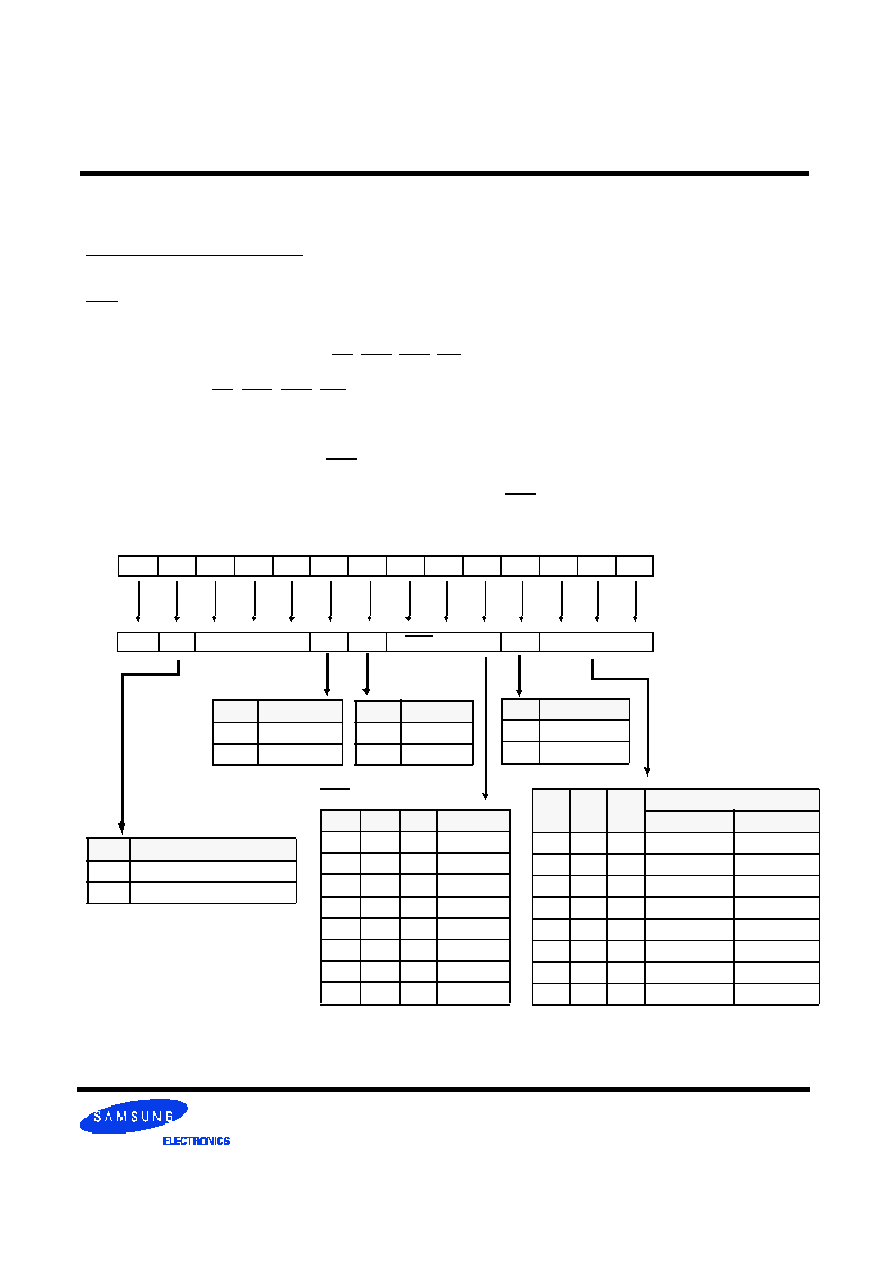
- 15 -
REV. 0.6 Oct. 21. 2002
128Mb D-die(x16) DDR SDRAM
3.2.2 Mode Register Definition
3.2.2.1 Mode Register Set(MRS)
The mode register stores the data for controlling the various operating modes of DDR SDRAM. It programs
CAS latency, addressing mode, burst length, test mode, DLL reset and various vendor specific options to make
DDR SDRAM useful for variety of different applications. The default value of the mode register is not defined,
therefore the mode register must be written after EMRS setting for proper DDR SDRAM operation. The mode
register is written by asserting low on CS, RAS, CAS, WE and BA0(The DDR SDRAM should be in all bank pre-
charge with CKE already high prior to writing into the mode register). The states of address pins A0 ~ A11 in
the same cycle as CS, RAS, CAS, WE and BA0 going low are written in the mode register. Two clock cycles
are requested to complete the write operation in the mode register. The mode register contents can be
changed using the same command and clock cycle requirements during operation as long as all banks are in
the idle state. The mode register is divided into various fields depending on functionality. The burst length uses
A0 ~ A2, addressing mode uses A3, CAS latency(read latency from column address) uses A4 ~ A6. A7 is used
for test mode. A8 is used for DLL reset. A7 must be set to low for normal MRS operation. Refer to the table for
specific codes for various burst lengths, addressing modes and CAS latencies.
Address Bus
CAS Latency
A
6
A
5
A
4
Latency
0
0
0
Reserved
0
0
1
Reserved
0
1
0
2
0
1
1
Reserved
1
0
0
Reserved
1
0
1
Reserved
1
1
0
2.5
1
1
1
Reserved
Burst Length
A
2
A
1
A
0
Burst Length
Sequential
Interleave
0
0
0
Reserve
Reserve
0
0
1
2
2
0
1
0
4
4
0
1
1
8
8
1
0
0
Reserve
Reserve
1
0
1
Reserve
Reserve
1
1
0
Reserve
Reserve
1
1
1
Reserve
Reserve
A
7
mode
0
Normal
1
Test
A
3
Burst Type
0
Sequential
1
Interleave
* RFU(Reserved for future use)
must stay "0" during MRS
cycle.
A
8
DLL Reset
0
No
1
Yes
Mode Register
BA
1
BA
0
A
11
A
10
A
9
A
8
A
7
A
6
A
5
A
4
A
3
A
2
A
1
A
0
RFU
TM
CAS Latency
BT
Burst Length
RFU
DLL
0
BA
0
A
n
~ A
0
0
(Existing)MRS Cycle
1
Extended Funtions(EMRS)
Figure 5. Mode Register Set

- 16 -
REV. 0.6 Oct. 21. 2002
128Mb D-die(x16) DDR SDRAM
Mode Register Set
*1 : MRS can be issued only at all bank precharge state.
*2 : Minimum
t
RP
is required to issue MRS command.
Command
2
0
1
5
3
4
8
6
7
t
CK
2 Clock min.
Precharge
All Banks
Mode
Register Set
t
RP
*2
*1
Any
Command
CK
CK
Burst Address Ordering for Burst Length
Burst
Length
Starting
Address(A2, A1, A0)
Sequential Mode
Interleave Mode
2
xx0
0, 1
0, 1
xx1
1, 0
1, 0
4
x00
0, 1, 2, 3
0, 1, 2, 3
x01
1, 2, 3, 0
1, 0, 3, 2
x10
2, 3, 0, 1
2, 3, 0, 1
x11
3, 0, 1, 2
3, 2, 1, 0
8
000
0, 1, 2, 3, 4, 5, 6, 7
0, 1, 2, 3, 4, 5, 6, 7
001
1, 2, 3, 4, 5, 6, 7, 0
1, 0, 3, 2, 5, 4, 7, 6
010
2, 3, 4, 5, 6, 7, 0, 1
2, 3, 0, 1, 6, 7, 4, 5
011
3, 4, 5, 6, 7, 0, 1, 2
3, 2, 1, 0, 7, 6, 5, 4
100
4, 5, 6, 7, 0, 1, 2, 3
4, 5, 6, 7, 0, 1, 2, 3
101
5, 6, 7, 0, 1, 2, 3, 4
5, 4, 7, 6, 1, 0, 3, 2
110
6, 7, 0, 1, 2, 3, 4, 5
6, 7, 4, 5, 2, 3, 0, 1
111
7, 0, 1, 2, 3, 4, 5, 6
7, 6, 5, 4, 3, 2, 1, 0
Table 4. Burst address ordering for burst length
Figure 6. Mode Register Set sequence
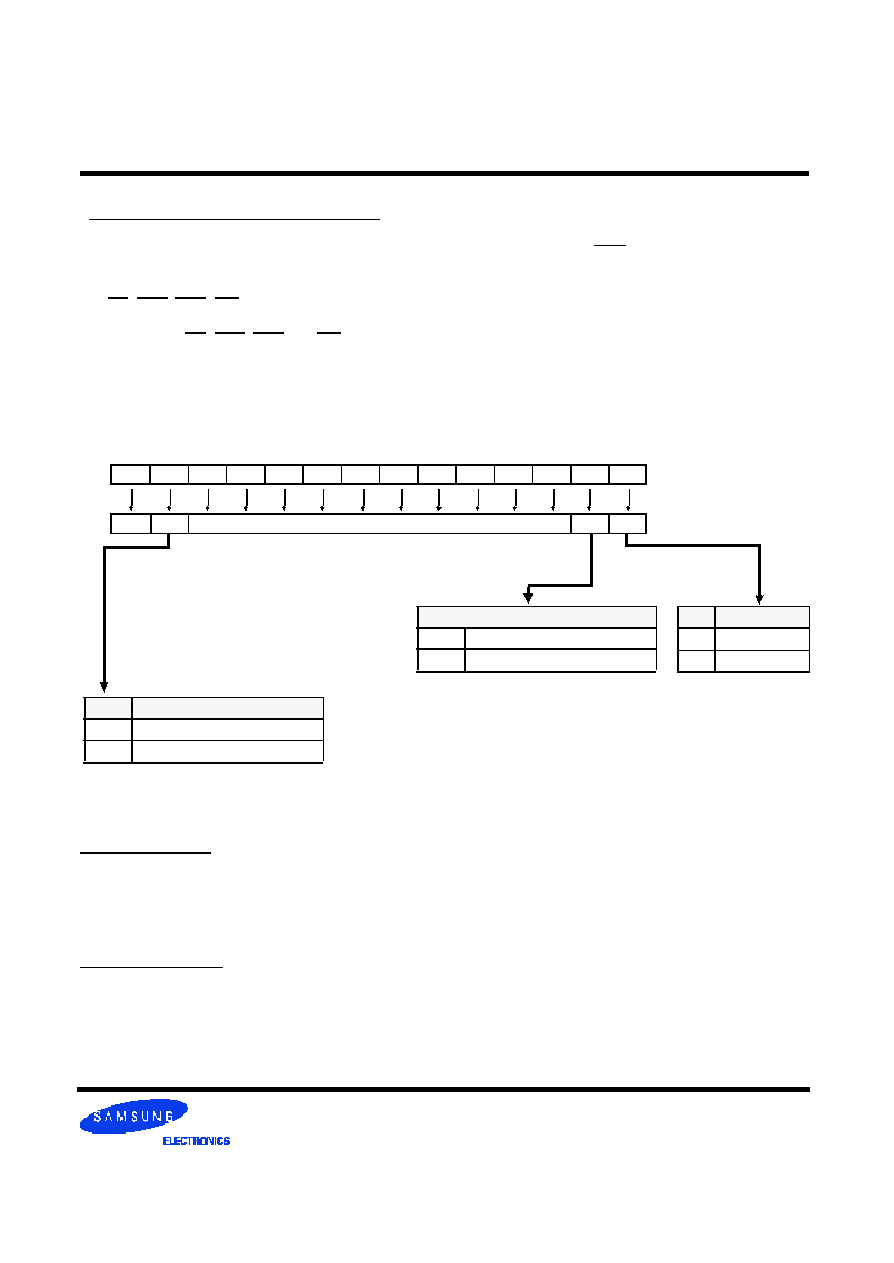
- 17 -
REV. 0.6 Oct. 21. 2002
128Mb D-die(x16) DDR SDRAM
3.2.2.2 Extended Mode Register Set(EMRS)
The extended mode register stores the data for enabling or disabling DLL, QFC and selecting output driver
size. The default value of the extended mode register is not defined, therefore the extened mode register must
be written after power up for enabling or disabling DLL. The extended mode register is written by asserting low
on CS, RAS, CAS, WE and high on BA0(The DDR SDRAM should be in all bank precharge with CKE already
high prior to writing into the extended mode register). The state of address pins A0 ~ A11 and BA1 in the
same cycle as CS, RAS, CAS and WE going low are written in the extended mode register. Two clock cycles
are required to complete the write operation in the extended mode register. The mode register contents can
be changed using the same command and clock cycle requirements during operation as long as all banks are
in the idle state. A0 is used for DLL enable or disable. "High" on BA0 is used for EMRS. All the other address
pins except A0 and BA0 must be set to low for proper EMRS operation. Refer to the table for specific codes.
Address Bus
*RFU
*RFU
Extended Mode Register
DLL
BA
1
BA
0
A
11
A
10
A
9
A
8
A
7
A
6
A
5
A
4
A
3
A
2
A
1
A
0
1
A
0
DLL Enable
0
Enable
1
Disable
BA
0
A
n
~ A
0
0
(Existing)MRS Cycle
1
Extended Funtions(EMRS)
Output Driver Impedence Control
0
Normal
1
Weak
D.I.C
Figure 7. Extend Mode Register set
DLL Enable/Disable
The DLL must be enabled for normal operation. DLL enable is required during power-up initialization, and
upon returing to normal operation after having disabled the DLL for the purpose of debug or evaluation (upon
exiting Self Refresh Mode, the DLL is enabled automatically). Any time the DLL is enabled, 200 clock cycles
must occur before a READ command can be issued.
Output Drive Strength
The normal drive strength for all outputs is specified to be SSTL_2, Class II. Samsung supports a weak driver
strength option, intended for lighter load and/or point-to-point environments. I-V curves for the normal drive
strength and weak drive strength are included in 11.1~2 of this document.
*RFU : Must be set "0"
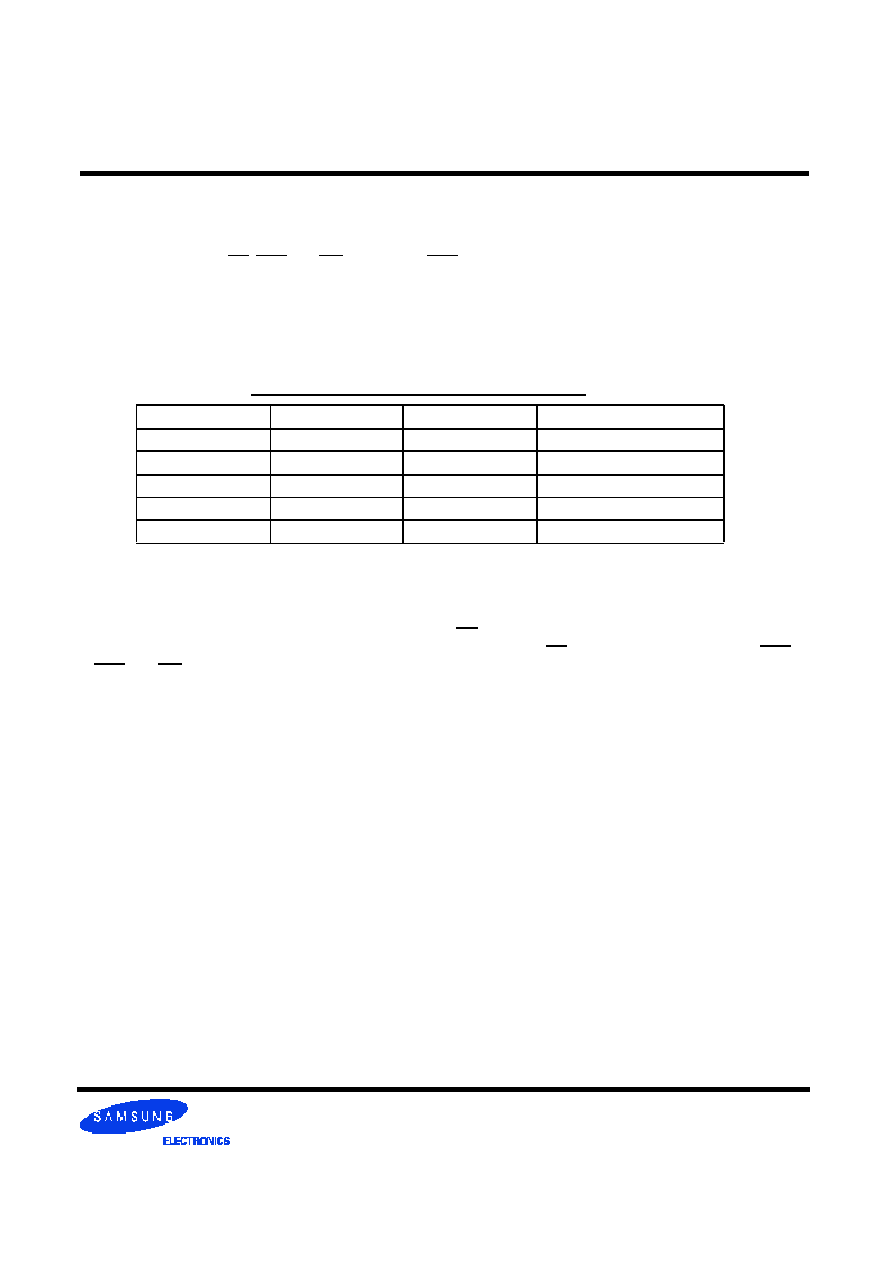
- 18 -
REV. 0.6 Oct. 21. 2002
128Mb D-die(x16) DDR SDRAM
3.2.3 Precharge
3.2.4 No Operation(NOP) & Device Deselect
The precharge command is used to precharge or close a bank that has been activated. The precharge com-
mand is issued when CS, RAS and WE are low and CAS is high at the rising edge of the clock. The precharge
command can be used to precharge each bank respectively or all banks simultaneously. The bank select
addresses(BA0, BA1) are used to define which bank is precharged when the command is initiated. For write
cycle, tWR(min.) must be satisfied until the precharge command can be issued. After tRP from the precharge,
an active command to the same bank can be initiated.
A10/AP
BA1
BA0
Precharge
0
0
0
Bank A Only
0
0
1
Bank B Only
0
1
0
Bank C Only
0
1
1
Bank D Only
1
X
X
All Banks
The device should be deselected by deactivating the CS signal. In this mode DDR SDRAM should ignore
all the control inputs. The DDR SDRAMs are put in NOP mode when CS is active and by deactivating RAS,
CAS and WE. For both Deselect and NOP the device should finish the current operation when this com-
mand is issued.
Bank Selection for Precharge by Bank address bits
Table 5. Bank selection for precharge by Bank address bits
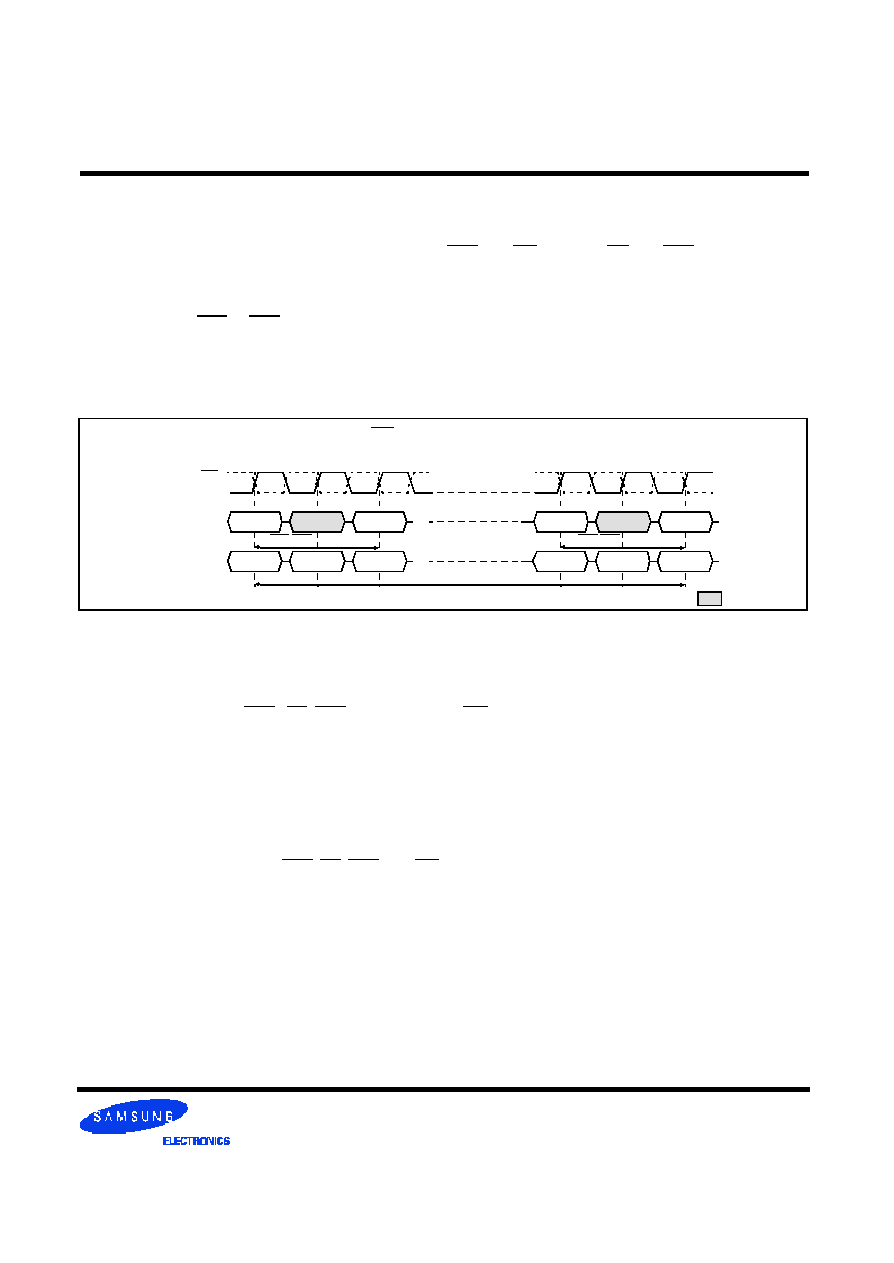
- 19 -
REV. 0.6 Oct. 21. 2002
128Mb D-die(x16) DDR SDRAM
3.2.5 Row Active
The Bank Activation command is issued by holding CAS and WE high with CS and RAS low at the rising
edge of the clock(CK). The DDR SDRAM has four independent banks, so two Bank Select addresses(BA0,
BA1) are required. The Bank Activation command must be applied before any Read or Write operation is exe-
cuted. The delay from the Bank Activation command to the first read or write command must meet or exceed
the minimum of RAS to CAS delay time(tRCD min). Once a bank has been activated, it must be precharged
before another Bank Activation command can be applied to the same bank. The minimum time interval
between interleaved Bank Activation commands(Bank A to Bank B and vice versa) is the Bank to Bank delay
time(tRRD min).
Address
Command
RAS-CAS delay(
t
RCD
)
Bank Activation Command Cycle
(CAS Latency = 2)
Bank A
Row Addr.
Bank A
Col. Addr.
Bank A
Activate
Write A
with Auto
NOP
Precharge
RAS-RAS delay time(
t
RRD
)
Bank B
Row Addr.
Bank A
Row. Addr.
Bank B
Activate
Bank A
Activate
NOP
ROW Cycle Time(
t
RC
)
Tn
Tn+1
Tn+2
2
0
1
: Don
t care
CK
CK
3.2.6 Read Bank
3.2.7 Write Bank
This command is used after the row activate command to initiate the burst read of data. The read command
is initiated by activating RAS, CS, CAS, and deasserting WE at the same clock sampling(rising) edge as
described in the command truth table. The length of the burst and the CAS latency time will be determined by
the values programmed during the MRS command.
This command is used after the row activate command to initiate the burst write of data. The write com-
mand is initiated by activating RAS, CS, CAS, and WE at the same clock sampling(rising) edge as described in
the command truth table. The length of the burst will be determined by the values programmed during the
MRS command.
Figure 8. Bank activation command cycle timing

- 20 -
REV. 0.6 Oct. 21. 2002
128Mb D-die(x16) DDR SDRAM
3.3.1 Burst Read Operation
Burst Read operation in DDR SDRAM is in the same manner as the current SDRAM such that the Burst read
command is issued by asserting CS and CAS low while holding RAS and WE high at the rising edge of the
clock(CK) after tRCD from the bank activation. The address inputs (A0~A9) determine the starting address for
the Burst. The Mode Register sets type of burst(Sequential or interleave) and burst length(2, 4, 8). The first
output data is available after the CAS Latency from the READ command, and the consecutive data are pre-
sented on the falling and rising edge of Data Strobe(DQS) adopted by DDR SDRAM until the burst length is
completed.
Command
< Burst Length=4, CAS Latency= 2, 2.5 >
READ A
NOP
NOP
NOP
NOP
NOP
NOP
NOP
NOP
DQS
DQ
s
CAS Latency=2
Dout 0 Dout 1 Dout 2 Dout 3
DQS
DQ
s
CAS Latency=2.5
Dout 0 Dout 1 Dout 2 Dout 3
2
0
1
5
3
4
8
6
7
t
RPRE
t
RPST
CK
CK
3.3 Essential Functionality for DDR SDRAM
The essential functionality that is required for the DDR SDRAM device is described in this chapter
Figure 9. Burst read operation timing
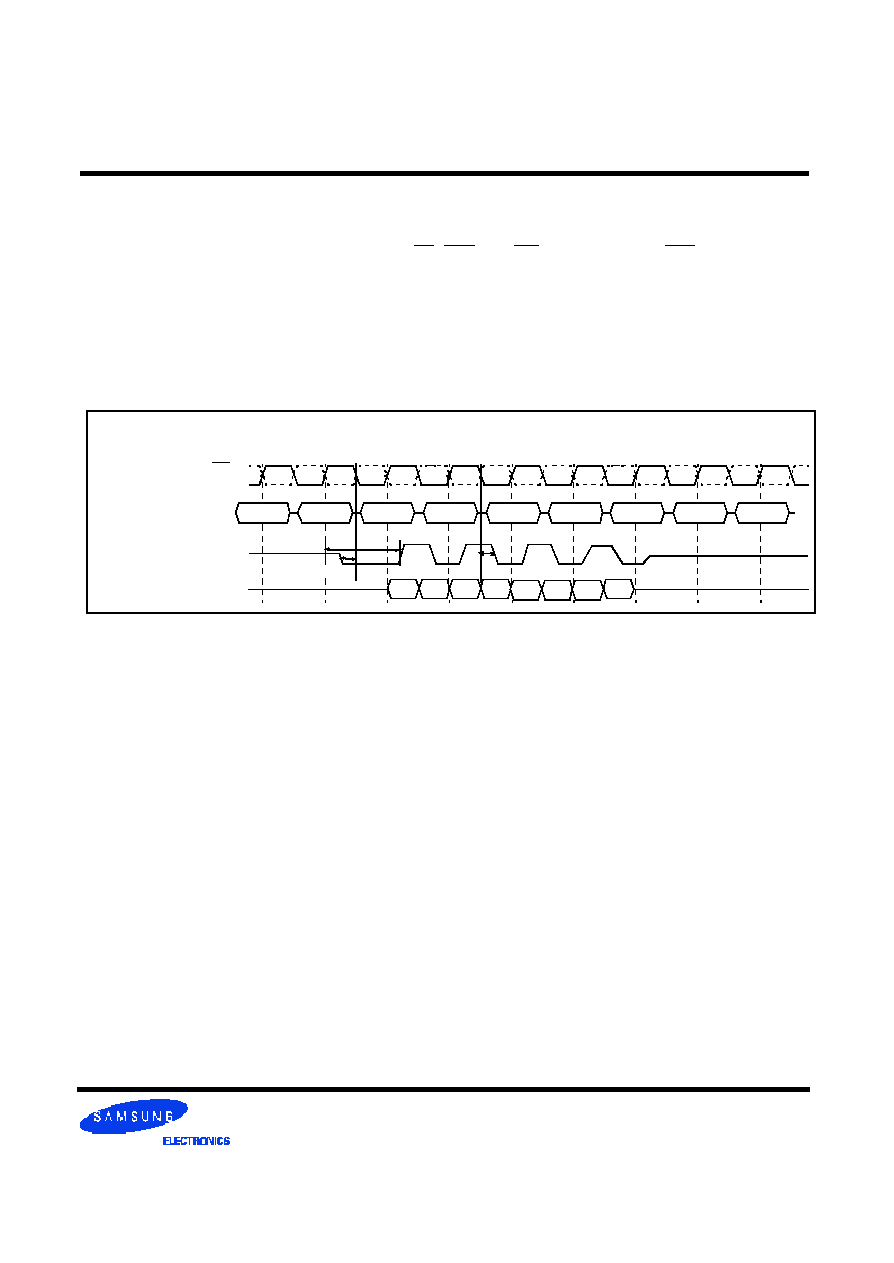
- 21 -
REV. 0.6 Oct. 21. 2002
128Mb D-die(x16) DDR SDRAM
3.3.2 Burst Write Operation
The Burst Write command is issued by having CS, CAS, and WE low while holding RAS high at the rising
edge of the clock(CK). The address inputs determine the starting column address. There is no write latency
relative to DQS required for burst write cycle. The first data of a burst write cycle must be applied on the DQ
pins tDS(Data-in setup time) prior to data strobe edge enabled after tDQSS from the rising edge of the
clock(CK) that the write command is issued. The remaining data inputs must be supplied on each subsequent
falling and rising edge of Data Strobe until the burst length is completed. When the burst has been finished, any
additional data supplied to the DQ pins will be ignored.
Figure 10. Burst write operation timing
1. The specific requirement is that DQS be valid(High or Low) on or before this CK edge. The case shown
(DQS going from High_Z to logic Low) applies when no writes were previously in progress on the bus.
If a previous write was in progress, DQS could be High at this time, depending on tDQSS.
*1
Command
< Burst Length=4 >
NOP
WRITE A
NOP
NOP
NOP
WRITEB
NOP
NOP
NOP
DQS
DQ
s
Din 3
Din 0 Din 1 Din 2
t
DQSSmax
2
0
1
5
3
4
8
6
7
t
WPRES*1
CK
CK
Din 3
Din 0 Din 1 Din 2
*1

- 22 -
REV. 0.6 Oct. 21. 2002
128Mb D-die(x16) DDR SDRAM
3.3.3 Read Interrupted by a Read
A Burst Read can be interrupted before completion of the burst by new Read command of any bank. When
the previous burst is interrupted, the remaining addresses are overridden by the new address with the full burst
length. The data from the first Read command continues to appear on the outputs until the CAS latency from
the interrupting Read command is satisfied. At this point the data from the interrupting Read command
appears. Read to Read interval is minimum 1 Clock.
Command
< Burst Length=4, CAS Latency=2 >
READ A
READ B
NOP
NOP
NOP
NOP
NOP
NOP
NOP
DQS
DQ
s
CAS Latency=2
D
out
A
0
D
out
A
1
D
out
B
0
D
out
B
1
D
out
B
2
D
out
B
3
2
0
1
5
3
4
8
6
7
CK
CK
3.3.4 Read Interrupted by a Write & Burst Stop
To interrupt a burst read with a write command, Burst Stop command must be asserted to avoid data conten-
tion on the I/O bus by placing the DQ
'
s(Output drivers) in a high impedance state. To insure the DQ
'
s are tri-
stated one cycle before the beginning the write operation, Burst stop command must be applied at least 2
clock cycles for CL=2 and at least 3 clock cycles for CL=2.5 before the Write command.
Command
< Burst Length=4, CAS Latency=2 >
READ
Burst Stop
NOP
WRITE
NOP
NOP
NOP
NOP
NOP
DQS
DQ
s
CAS Latency=2
Dout 0 Dout 1
Din 0
Din 1
Din 2
Din 3
2
0
1
5
3
4
8
6
7
CK
CK
The following functionality establishes how a Write command may interrupt a Read burst.
1. For Write commands interrupting a Read burst, a Burst Terminate command is required to stop the read
burst and tristate the DQ bus prior to valid input write data. Once the Burst Terminate command has been
issued, the minimum delay to a Write command = RU(CL) [CL is the CAS Latency and RU means round up
to the nearest integer].
2. It is illegal for a Write command to interrupt a Read with autoprecharge command.
Figure 11. Read interrupted by a read timing
Figure 12. Read interrupted by a write and burst stop timing.
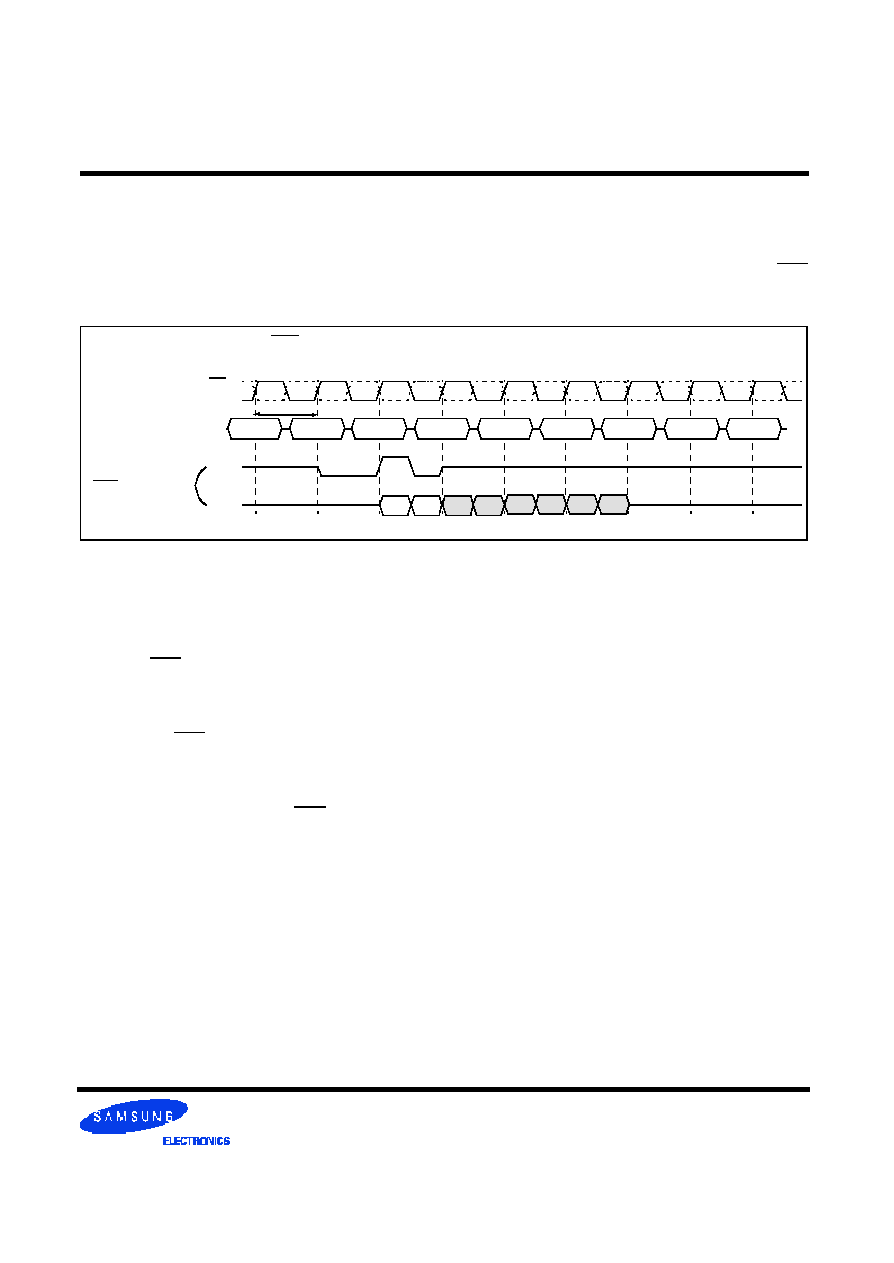
- 23 -
REV. 0.6 Oct. 21. 2002
128Mb D-die(x16) DDR SDRAM
3.3.5 Read Interrupted by a Precharge
A Burst Read operation can be interrupted by precharge of the same bank. The minimum 1 clock is required
for the read to precharge intervals. A precharge command to output disable latency is equivalent to the CAS
latency.
Command
< Burst Length=8, CAS Latency=2 >
READ
NOP
Precharge
NOP
NOP
NOP
NOP
NOP
NOP
DQS
DQ
s
CAS Latency=2
Dout 0 Dout 1 Dout 2 Dout 3
Interrupted by precharge
2
0
1
5
3
4
8
6
7
Dout 4 Dout 5 Dout 6 Dout 7
1t
CK
CK
CK
When a burst Read command is issued to a DDR SDRAM, a Precharge command may be issued to the same
bank before the Read burst is complete. The following functionality determines when a Precharge command
may be given during a Read burst and when a new Bank Activate command may be issued to the same bank.
1. For the earliest possible Precharge command without interrupting a Read burst, the Precharge command
may be given on the rising clock edge which is CL clock cycles before the end of the Read burst where CL
is the CAS Latency. A new Bank Activate command may be issued to the same bank after tRP (RAS
Precharge time).
2. When a Precharge command interrupts a Read burst operation, the Precharge command may be given on
the rising clock edge which is CL clock cycles before the last data from the interrupted Read burst where
CL is the CAS Latency. Once the last data word has been output, the output buffers are tristated. A new
Bank Activate command may be issued to the same bank after tRP.
3. For a Read with autoprecharge command, a new Bank Activate command may be issued to the same
bank after tRP where tRP begins on the rising clock edge which is CL clock cycles before the end of the
Read burst where CL is the CAS Latency. During Read with autoprecharge, the initiation of the internal
precharge occurs at the same time as the earliest possible external Precharge command would initiate a
precharge operation without interrupting the Read burst as described in 1 above.
4. For all cases above, tRP is an analog delay that needs to be converted into clock cycles. The number of
clock cycles between a Precharge command and a new Bank Activate command to the same bank equals
tRP/tCK (where tCK is the clock cycle time) with the result rounded up to the nearest integer number of
clock cycles. (Note that rounding to X.5 is not possible since the Precharge and Bank Activate commands
can only be given on a rising clock edge).
In all cases, a Precharge operation cannot be initiated unless tRAS(min) [minimum Bank Activate to Precharge
time] has been satisfied. This includes Read with autoprecharge commands where tRAS(min) must still be
satisfied such that a Read with autoprecharge command has the same timing as a Read command followed by
the earliest possible Precharge command which does not interrupt the burst.
Figure 13. Read interrupted by a precharge timing

- 24 -
REV. 0.6 Oct. 21. 2002
128Mb D-die(x16) DDR SDRAM
3.3.6 Write Interrupted by a Write
A Burst Write can be interrupted before completion of the burst by a new Write command, with the only restric-
tion that the interval that separates the commands must be at least one clock cycle. When the previous burst
is interrupted, the remaining addresses are overridden by the new address and data will be written into the
device until the programmed burst length is satisfied.
Command
< Burst Length=4 >
NOP
WRITE A
WRITE b
NOP
NOP
NOP
NOP
NOP
NOP
DQS
DQ
s
Din A
0
Din A
1
Din B
0
Din B
1
Din B
2
Din B
3
1t
CK
2
0
1
5
3
4
8
6
7
CK
CK
Figure 14. Write interrupted by a write timing
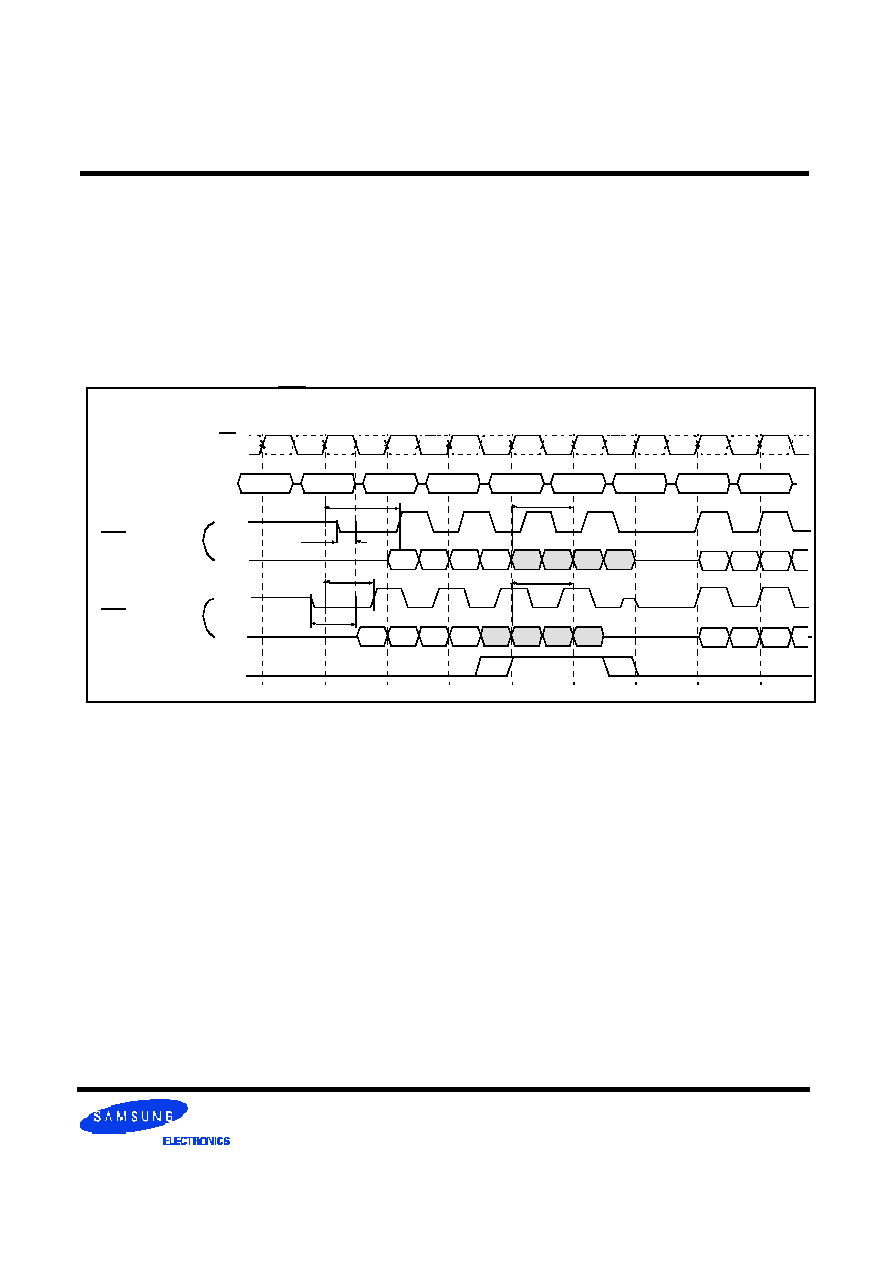
- 25 -
REV. 0.6 Oct. 21. 2002
128Mb D-die(x16) DDR SDRAM
3.3.7 Write Interrupted by a Read & DM
A burst write can be interrupted by a read command of any bank. The DQ
'
s must be in the high impedance
state at least one clock cycle before the interrupting read data appear on the outputs to avoid data contention.
When the read command is registered, any residual data from the burst write cycle must be masked by DM.
The delay from the last data to read command (tCDLR) is required to avoid the data contention DRAM inside.
Data that are presented on the DQ pins before the read command is initiated will actually be written to the
memory. Read command interrupting write can not be issued at the next clock edge of that of write command.
Command
< Burst Length=8, CAS Latency=2 >
NOP
WRITE
NOP
NOP
READ
NOP
NOP
NOP
NOP
DQS
DQ
s
Din 0
Din 1
Din 2
Din 3
Din 4
Din 5
Dout 0 Dout 1 Dout 2
Din 6
Din 7
t
WTR
CAS Latency=2
t
DQSSmax
DQS
DQ
s
t
WTR
CAS Latency=2
t
DQSSmin
Din 7
Din 0
Din 1
Din 2
Din 3
Din 4
Din 5
Din 6
DM
Do
Dout 0 Dout 1 Dout 2 Do
2
0
1
5
3
4
8
6
7
t
WPRES*
5
t
WPRES*
5
CK
CK
The following function established how a Read command may interrupt a Write burst and which input data is
not written into the memory.
1. For Read commands interrupting a Write burst, the minimum Write to Read command delay is 2 clock
cycles. The case where the Write to Read delay is 1 clock cycle is disallowed
2. For Read commands interrupting a Write burst, the DM pin must be used to mask the input data words
whcich immediately precede the interrupting Read operation and the input data word which immediately
follows the interrupting Read operation
3. For all cases of a Read interrupting a Write, the DQ and DQS buses must be released by the driving chip
(i.e., the memory controller) in time to allow the buses to turn around before the DDR SDRAM drives them
during a read operation.
4. If input Write data is masked by the Read command, the DQS input is ignored by the DDR SDRAM.
5. Refer to "3.3.2 Burst write operation"
Figure 15. Write interrupted by a read and DM timing

- 26 -
REV. 0.6 Oct. 21. 2002
128Mb D-die(x16) DDR SDRAM
3.3.8 Write Interrupted by a Precharge & DM
A burst write operation can be interrupted before completion of the burst by a precharge of the same bank.
Random column access is allowed. A write recovery time(tWR) is required from the last data to precharge
command. When precharge command is asserted, any residual data from the burst write cycle must be
masked by DM.
Precharge timing for Write operations in DRAMs requires enough time to allow "write recovery" which is the
time required by a DRAM core to properly store a full "0" or "1" level before a Precharge operation. For DDR
SDRAM, a timing parameter, tWR, is used to indicate the required amount of time between the last valid write
operation and a Precharge command to the same bank.
The precharge timing for writes is a complex definition since the write data is sampled by the data strobe and
the address is sampled by the input clock. Inside the SDRAM, the data path is eventually synchronized with
the address path by switching clock domains from the data strobe clock domain to the input clock domain.
This makes the definition of when a precharge operation can be initiated after a write very complex since the
write recovery parameter must reference only the clock domain that is used to time the internal write operation,
i.e., the input clock domain.
tWR starts on the rising clock edge after the last possible DQS edge that strobed in the last valid data and
ends on the rising clock edge that strobes in the precharge command.
1. For the earliest possible Precharge command following a Write burst without interrupting the burst, the
minimum time for write recovery is defined by tWR.
2. When a precharge command interrupts a Write burst operation, the data mask pin, DM, is used to mask
input data during the time between the last valid write data and the rising clock edge on which the
Precharge command is given. During this time, the DQS input is still required to strobe in the state of DM.
The minimum time for write recovery is defined by tWR.
Figure 16. Write interrupted by a precharge and DM timing
Command
< Burst Length=8 >
NOP
WRITE A
NOP
NOP
Precharge
NOP
NOP
NOP
WRITEB
DQS
DQ
s
Dina
0
Dina
1
Dina
2
Dina
3
Dina
4
Dina
5
Dinb
0
Dina
6
Dina
7
t
WR
DQS
DQ
s
t
DQSSmin
Dina
7
Dina
0
Dina
1
Dina
2
Dina
3
Dina
4
Dina
5
Dina
6
DM
Dinb
0
Dinb
1
t
DQSSmax
2
0
1
5
3
4
8
6
7
CK
CK
t
WPRES*
5
t
WPRES*
5
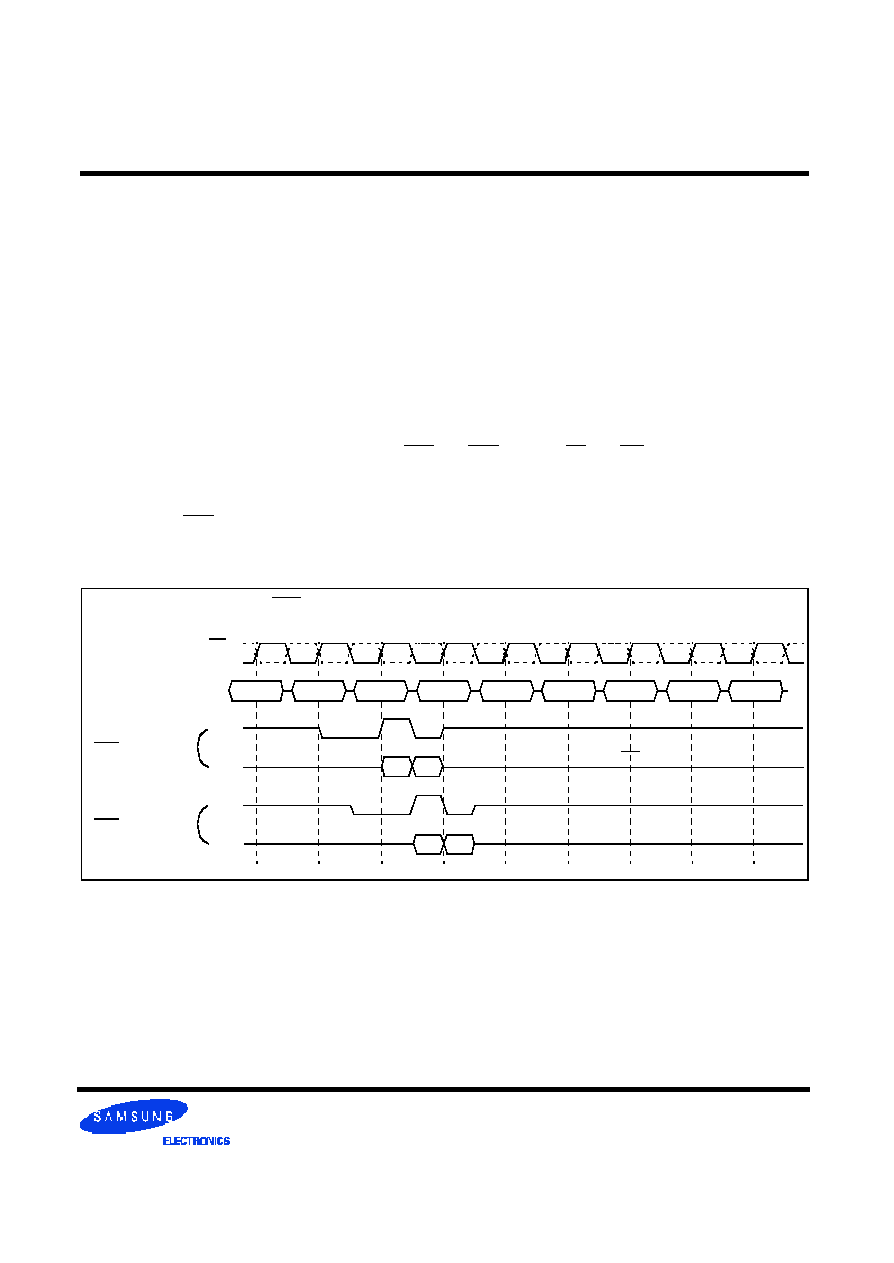
- 27 -
REV. 0.6 Oct. 21. 2002
128Mb D-die(x16) DDR SDRAM
3. For a Write with autoprecharge command, a new Bank Activate command may be issued to the same
bank after tWR+tRP where tWR+tRP starts on the falling DQS edge that strobed in the last valid data and
ends on the rising clock edge that strobes in the Bank Activate command. During write with
autoprecharge, the initiation of the internal precharge occurs at the same time as the earliest possible
external Precharge command without interrupting the Write burst as described in 1 above.
4. In all cases, a Precharge operation cannot be initiated unless tRAS(min) [minimum Bank Activate to
Precharge time] has been satisfied. This includes Write with autoprecharge commands where tRAS(min)
must still be satisfied such that a Write with autoprecharge command has the same timing as a Write
command followed by the earliest possible Precharge command which does not interrupt the burst.
5. Refer to "3.3.2 Burst write operation"
3.3.9 Burst Stop
The burst stop command is initiated by having RAS and CAS high with CS and WE low at the rising edge of
the clock(CK). The burst stop command has the fewest restrictions making it the easiest method to use when
terminating a burst read operation before it has been completed. When the burst stop command is issued dur-
ing a burst read cycle, the pair of data and DQS(Data Strobe) go to a high impedance state after a delay which
is equal to the CAS latency set in the mode register. The burst stop command, however, is not supported dur-
ing a write burst operation.
Command
< Burst Length=4, CAS Latency= 2, 2.5 >
READ A
Burst Stop
NOP
NOP
NOP
NOP
NOP
NOP
NOP
DQS
DQ
s
CAS Latency=2
Dout 0 Dout 1
DQS
DQ
s
CAS Latency=2.5
The burst ends after a delay equal to the CAS latency.
Dout 0 Dout 1
2
0
1
5
3
4
8
6
7
CK
CK
The Burst Stop command is a mandatory feature for DDR SDRAMs. The following functionality is required:
1. The BST command may only be issued on the rising edge of the input clock, CK.
2. BST is only a valid command during Read bursts.
3. BST during a Write burst is undefined and shall not be used.
4. BST applies to all burst lengths.
5. BST is an undefined command during Read with autoprecharge and shall not be used.
Figure 17. Burst stop timing
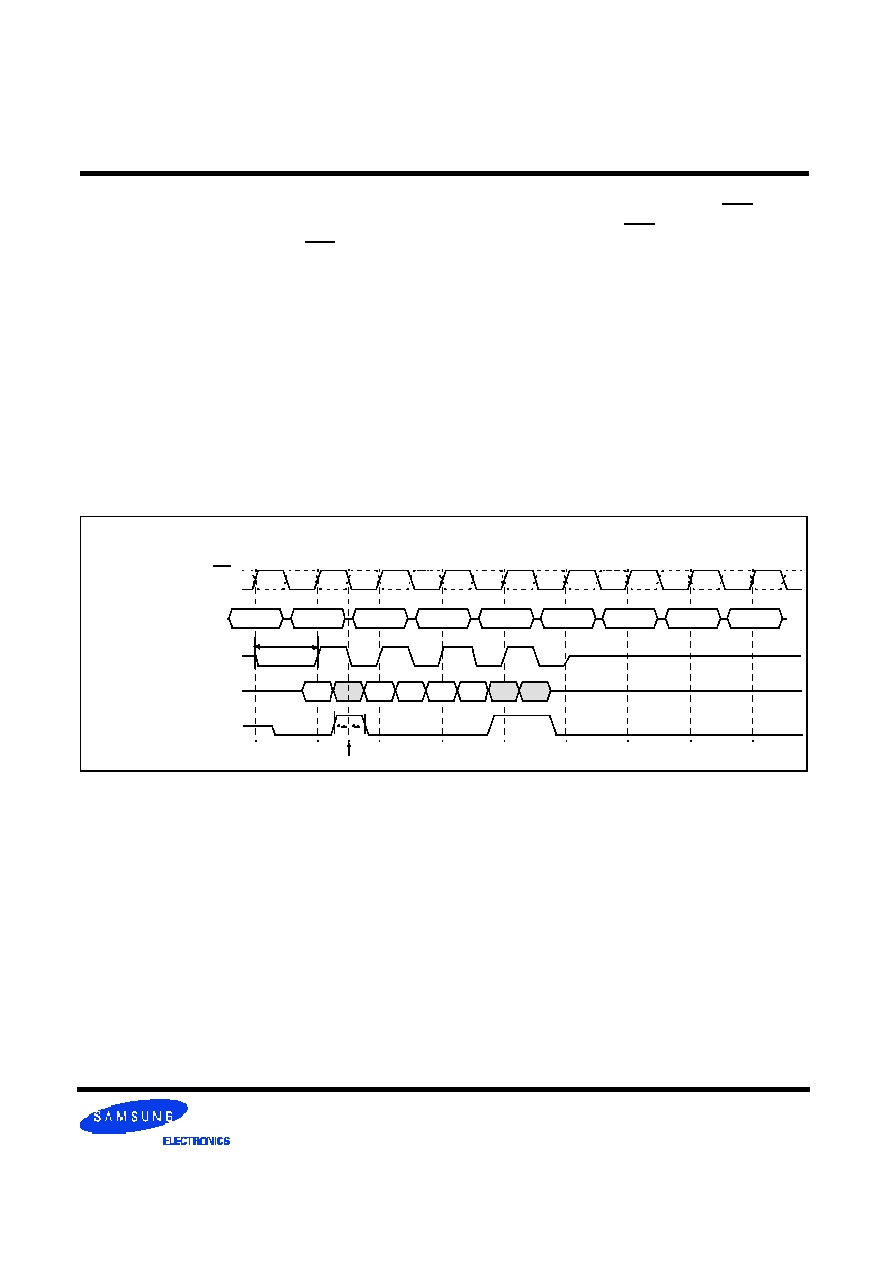
- 28 -
REV. 0.6 Oct. 21. 2002
128Mb D-die(x16) DDR SDRAM
3.3.10 DM masking
The DDR SDRAM has a data mask function that can be used in conjunction with data write cycle, not read
cycle. When the data mask is activated (DM high) during write operation, DDR SDRAM does not accept the
corresponding data.(DM to data-mask latency is zero).
DM must be issued at the rising or falling edge of data strobe.
6. When terminating a burst Read command, the BST command must be issued L
BST
("BST Latency") clock
cycles before the clock edge at which the output buffers are tristated, where L
BST
equals the CAS latency
for read operations. This is shown in previous page Figure with examples for CAS latency (CL) of 1.5, 2,
2.5, 3 and 3.5 (only selected CAS latencies are required by the DDR SDRAM standards, the others are
optional).
7. When the burst terminates, the DQ and DQS pins are tristated.
The BST command is not byte controllable and applies to all bits in the DQ data word and the(all) DQS pin(s).
Figure 18. DM masking timing
Command
< Burst Length=8 >
WRITE
NOP
NOP
NOP
NOP
NOP
NOP
NOP
NOP
DQS
DQ
s
Din 0 Din 1 Din 2 Din 3
t
DQSS
DM
Din 4 Din 5 Din 6 Din7
masked by DM=H
2
0
1
5
3
4
8
6
7
CK
CK
t
DS
t
DH
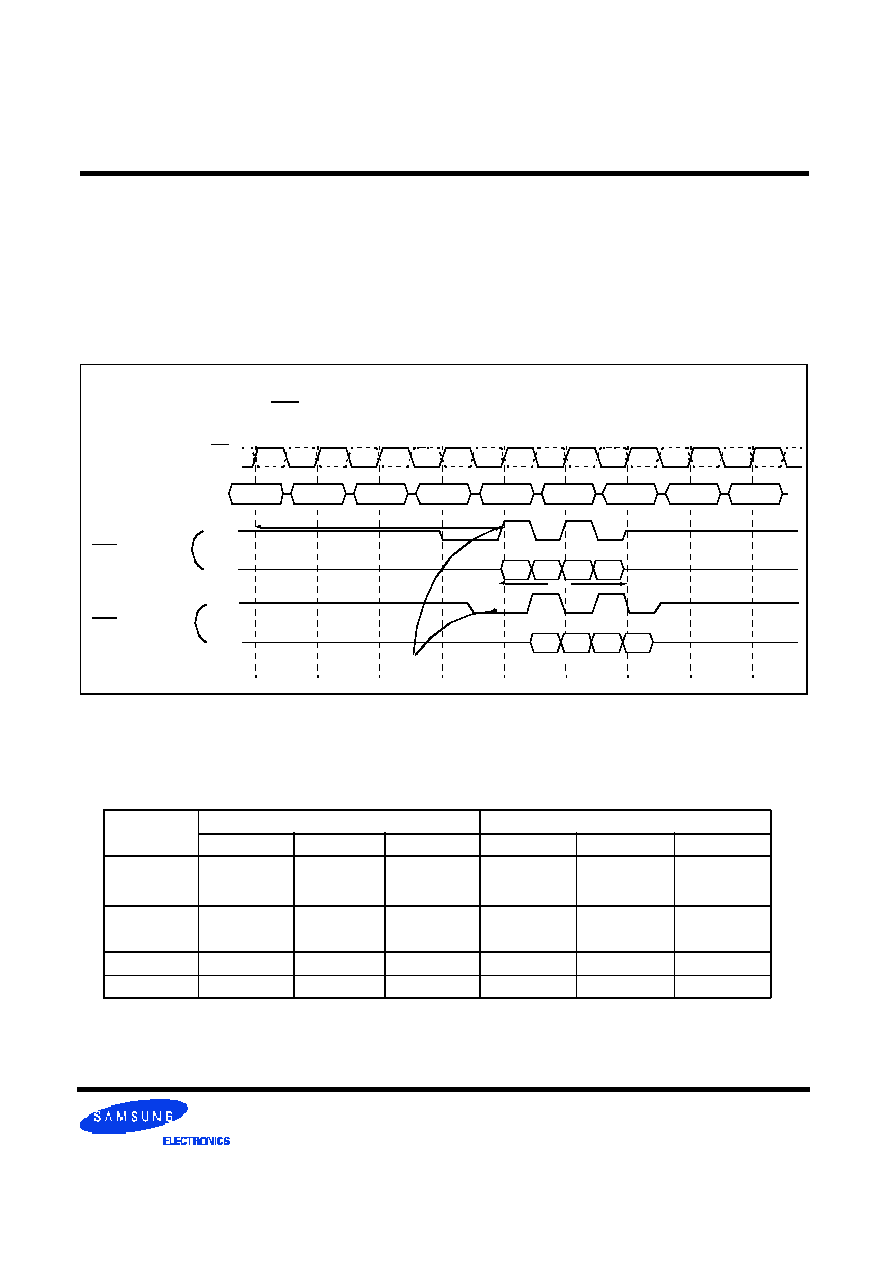
- 29 -
REV. 0.6 Oct. 21. 2002
128Mb D-die(x16) DDR SDRAM
Command
< Burst Length=4, CAS Latency= 2, 2.5>
BANK A
NOP
READ A
NOP
NOP
NOP
NOP
NOP
NOP
DQS
DQ
s
CAS Latency=2
Dout 0 Dout 1 Dout 2 Dout 3
ACTIVE
Auto Precharge
* Bank can be reactivated at the
t
RP
completion of
precharge
Begin Auto-Precharge
DQS
DQ
s
CAS Latency=2.5
Dout 0 Dout 1 Dout 2 Dout 3
When the Read with Auto precharge command is issued, new command can be asserted at 3,4 and 5
respectively as follows,
Asserted
command
For same Bank
For Different Bank
3
4
5
3
4
5
READ
READ +
No AP
*1
READ+
No AP
Illegal
Legal
Legal
Legal
READ+AP
READ +
AP
READ +
AP
Illegal
Legal
Legal
Legal
Active
Illegal
Illegal
Illegal
Legal
Legal
Legal
Precharge
Legal
Legal
Illegal
Legal
Legal
Legal
*1
: AP = Auto Precharge
2
0
1
5
3
4
8
6
7
t
RAS(min.)
CK
CK
3.3.11 Read With Auto Precharge
If a read with auto-precharge command is initiated, the DDR SDRAM automatically enters the precharge
operation BL/2 clock later from a read with auto-precharge command when tRAS(min) is satisfied. If not, the
start point of precharge operation will be delayed until tRAS(min) is satisfied. Once the precharge operation
has started the bank cannot be reactivated and the new command can not be asserted until the precharge
time(tRP) has been satisfied.
Figure 19. Read with auto precharge timing
Table 6. Operating description when new command asserted
while read with auto precharge is issued

- 30 -
REV. 0.6 Oct. 21. 2002
128Mb D-die(x16) DDR SDRAM
3.3.12 Write with Auto Precharge
If A10 is high when write command is issued , the write with auto-precharge function is performed. Any new
command to the same bank should not be issued until the internal precharge is completed. The internal pre-
charge begins after keeping tWR(min).
Figure 20. Write with auto precharge timing
Asserted
command
For same Bank
For Different Bank
3
4
5
6
7
8
3
4
5
6
7
WRITE
WRITE+
No AP
*1
WRITE+
No AP
Illegal
Illegal
Illegal
Illegal
Legal
Legal
Legal
Legal
Legal
WRITE+
AP
WRITE+
AP
WRITE+
AP
Illegal
Illegal
Illegal
Illegal
Legal
Legal
Legal
Legal
Legal
READ
Illegal
READ+NO
AP+DM
*2
READ+NO
AP+DM
READ+
NO AP
Illegal
Illegal
Illegal
Illegal
Illegal
Legal
Legal
READ+AP
Illegal
READ +
AP+DM
READ +
AP+DM
READ +
AP
Illegal
Illegal
Illegal
Illegal
Illegal
Legal
Legal
Active
Illegal
Illegal
Illegal
Illegal
Illegal
Illegal
Legal
Legal
Legal
Legal
Legal
Precharge
Illegal
Illegal
Illegal
Illegal
Illegal
Illegal
Legal
Legal
Legal
Legal
Legal
*1
: AP = Auto Precharge
*2
: DM : Refer to " 3.3.7 Write Interrupted by a Read & DM " in page 25.
Burst length = 4
Table 7. Operating description when new command asserted
while write with auto precharge is issued
Command
<100Mhz, Burst Length=4 >
BANK A
NOP
WRITE A
NOP
NOP
NOP
NOP
NOP
NOP
DQS
DQ
s
Din 0 Din 1 Din 2 Din 3
ACTIVE
Auto Precharge
* Bank can be reactivated at
completion of
t
RP
t
WR
t
RP
Internal precharge start
2
0
1
5
3
4
8
6
7
CK
CK
NOP
t
DAL

- 31 -
REV. 0.6 Oct. 21. 2002
128Mb D-die(x16) DDR SDRAM
3.3.13 Auto Refresh & Self Refresh
Auto Refresh
Command
CKE
PRE
t
RP
t
RFC
Auto
= High
Refresh
CMD
An auto refresh command is issued by having CS, RAS and CAS held low with CKE and WE high at the ris-
ing edge of the clock(CK). All banks must be precharged and idle for tRP(min) before the auto refresh com-
mand is applied. No control of the external address pins is required once this cycle has started because of the
internal address counter. When the refresh cycle has completed, all banks will be in the idle state. A delay
between the auto refresh command and the next activate command or subsequent auto refresh command
must be greater than or equal to the tRFC(min).
CK
CK
Self Refresh
A self refresh command is defined by having CS, RAS, CAS and CKE held low with WE high at the rising
edge of the clock(CK). Once the self refresh command is initiated, CKE must be held low to keep the device in
self refresh mode. During the self refresh operation, all inputs except CKE are ignored. The clock is internally
disabled during self refresh operation to reduce power consumption. The self refresh is exited by supplying
stable clock input before returning CKE high, asserting deselect or NOP command and then asserting CKE
high for longer than tXSR for locking of DLL.
Command
CKE
t
XSNR
* 1
Self
Refresh
CK
CK
Read
t
XSRD*
2
Figure 21. Auto refresh timing
Figure 22. Self refresh timing
Active
1. Exit self refresh to bank active command, a write command can be applied as far as tRCD is satisfied after
any bank active command.
2. Exit self refresh to read command

- 32 -
REV. 0.6 Oct. 21. 2002
128Mb D-die(x16) DDR SDRAM
3.3.14 Power down
CKE
Precharge
Active
Active
Read
power
down
Exit
Active
power
down
Entry
power
Entry
down
Precharge
Command
CK
CK
The power down mode is entered when CKE is low and exited when CKE is high. Once the power down
mode is initiated, all of the receiver circuits except clock, CKE and DLL circuit tree are gated off to reduce
power consumption. All banks should be in idle state prior to entering the precharge power down mode and
CKE should be set high at least 1tck+tIS prior to row active command . During power down mode, refresh
operations cannot be performed, therefore the device cannot be remained in power down mode longer than
the refresh period(Data retension time) of the device.
Figure 23. Power down entry and exit timing
t
IS
t
PDEX

- 33 -
REV. 0.6 Oct. 21. 2002
128Mb D-die(x16) DDR SDRAM
4. Command Truth Table
(V=Valid, X=Don
t Care, H=Logic High, L=Logic Low)
COMMAND
CKEn-1
CKEn
CS
RAS
CAS
WE
BA
0,1
A
10
/AP
A
11,
A
9
~ A
0
Note
Register
Extended MRS
H
X
L
L
L
L
OP CODE
1, 2
Register
Mode Register Set
H
X
L
L
L
L
OP CODE
1, 2
Refresh
Auto Refresh
H
H
L
L
L
H
X
3
Self
Refresh
Entry
L
3
Exit
L
H
L
H
H
H
X
3
H
X
X
X
3
Bank Active & Row Addr.
H
X
L
L
H
H
V
Row Address
Read &
Column Address
Auto Precharge Disable
H
X
L
H
L
H
V
L
Column
Address
(A
0
~A
9
)
4
Auto Precharge Enable
H
4
Write &
Column Address
Auto Precharge Disable
H
X
L
H
L
L
V
L
Column
Address
(A
0
~A
9
)
4
Auto Precharge Enable
H
4, 6
Burst Stop
H
X
L
H
H
L
X
7
Precharge
Bank Selection
H
X
L
L
H
L
V
L
X
All Banks
X
H
5
Active Power Down
Entry
H
L
H
X
X
X
X
L
V
V
V
Exit
L
H
X
X
X
X
Precharge Power Down Mode
Entry
H
L
H
X
X
X
X
L
H
H
H
Exit
L
H
H
X
X
X
L
V
V
V
DM
H
X
X
8
No operation (NOP) : Not defined
H
X
H
X
X
X
X
9
L
H
H
H
9
1. OP Code : Operand Code. A
0
~ A
11
& BA
0
~ BA
1
: Program keys. (@EMRS/MRS)
2.EMRS/ MRS can be issued only at all banks precharge state.
A new command can be issued 2 clock cycles after EMRS or MRS.
3. Auto refresh functions are same as the CBR refresh of DRAM.
The automatical precharge without row precharge command is meant by "Auto".
Auto/self refresh can be issued only at all banks precharge state.
4. BA
0
~ BA
1
: Bank select addresses.
If both BA
0
and BA
1
are "Low" at read, write, row active and precharge, bank A is selected.
If BA
0
is "High" and BA
1
is "Low" at read, write, row active and precharge, bank B is selected.
If BA
0
is "Low" and BA
1
is "High" at read, write, row active and precharge, bank C is selected.
If both BA
0
and BA
1
are "High" at read, write, row active and precharge, bank D is selected.
5. If A
10
/AP is "High" at row precharge, BA
0
and BA
1
are ignored and all banks are selected.
6. During burst write with auto precharge, new read/write command can not be issued.
Another bank read/write command can be issued after the end of burst.
New row active of the associated bank can be issued at t
RP
after the end of burst.
7. Burst stop command is valid at every burst length.
8. DM sampled at the rising and falling edges of the DQS and Data-in are masked at the both edges (Write DM latency is 0).
9. This combination is not defined for any function, which means "No Operation(NOP)" in DDR SDRAM.
Table 8. Command truth table

- 34 -
REV. 0.6 Oct. 21. 2002
128Mb D-die(x16) DDR SDRAM
5. Functional Truth Table
Current State
CS
RAS CAS
W E
Address
Command
Action
PRECHARGE
STANDBY
L
H
H
L
X
Burst Stop
ILLEGAL*2
L
H
L
X
BA, CA, A
10
READ/WRITE
ILLEGAL*2
L
L
H
H
BA, RA
Active
Bank Active, Latch RA
L
L
H
L
BA, A
10
PRE/PREA
ILLEGAL*4
L
L
L
H
X
Refresh
AUTO-Refresh*5
L
L
L
L
Op-Code, Mode-Add
MRS
Mode Register Set*5
ACTIVE
STANDBY
L
H
H
L
X
Burst Stop
NOP
L
H
L
H
BA, CA, A
10
READ/READA
Begin Read, Latch CA,
Determine Auto-Precharge
L
H
L
L
BA, CA, A
10
WRITE/WRITEA Begin Write, Latch CA,
Determine Auto-Precharge
L
L
H
H
BA, RA
Active
Bank Active/ILLEGAL*2
L
L
H
L
BA, A
10
PRE/PREA
Precharge/Precharge All
L
L
L
H
X
Refresh
ILLEGAL
L
L
L
L
Op-Code, Mode-Add
MRS
ILLEGAL
READ
L
H
H
L
X
Burst Stop
Terminate Burst
L
H
L
H
BA, CA, A
10
READ/READA
Terminate Burst, Latch CA,
Begin New Read, Determine
Auto-Precharge*3
L
H
L
L
BA, CA, A
10
WRITE/WRITEA ILLEGAL
L
L
H
H
BA, RA
Active
Bank Active/ILLEGAL*2
L
L
H
L
BA, A
10
PRE/PREA
Terminate Burst, Precharge
L
L
L
H
X
Refresh
ILLEGAL
L
L
L
L
Op-Code, Mode-Add
MRS
ILLEGAL
Table 9-1. Functional truth table
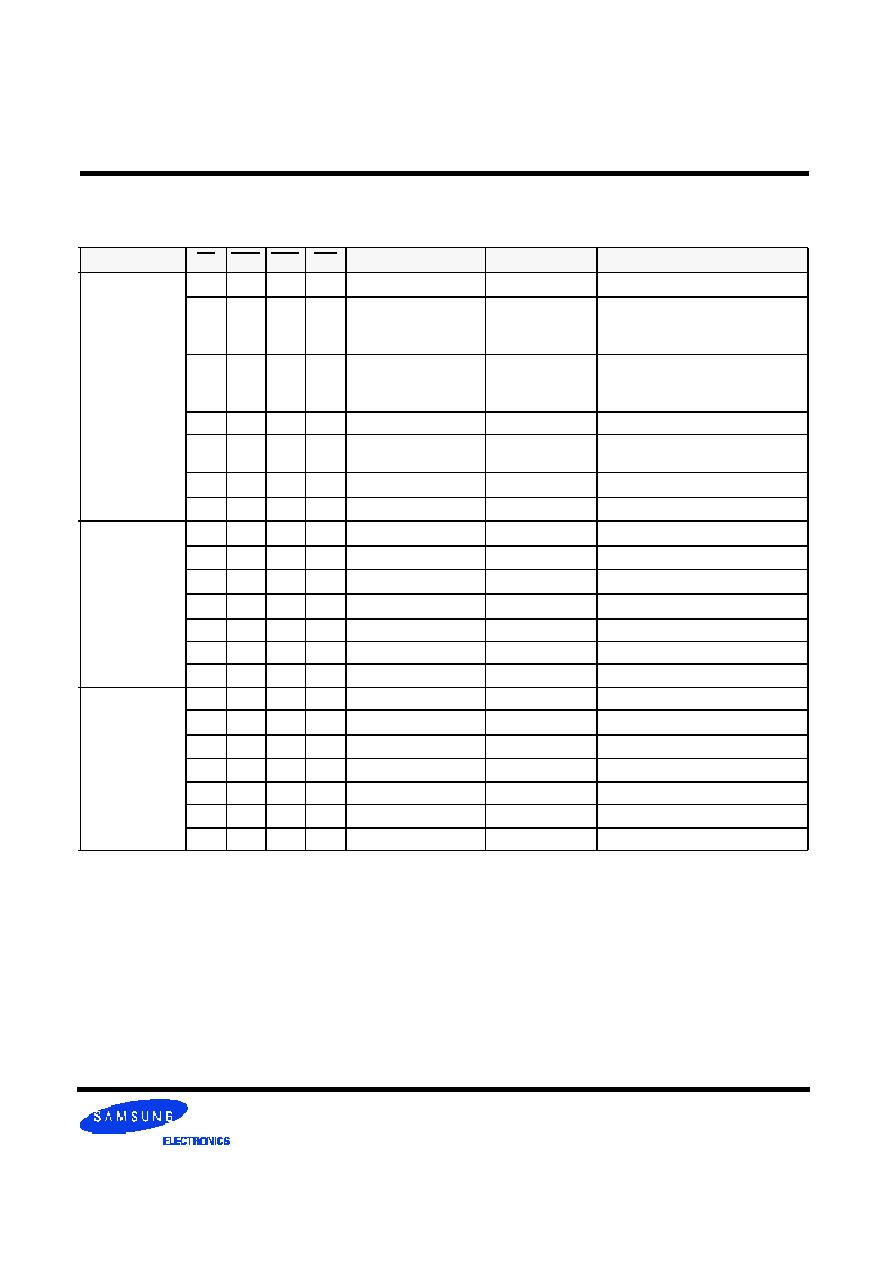
- 35 -
REV. 0.6 Oct. 21. 2002
128Mb D-die(x16) DDR SDRAM
Current State
CS
RAS CAS
W E
Address
Command
Action
WRITE
L
H
H
L
X
Burst Stop
ILLEGAL
L
H
L
H
BA, CA, A
10
READ/READA
Terminate Burst With DM=High,
Latch CA, Begin Read, Deter-
mine Auto-Precharge*3
L
H
L
L
BA, CA, A
10
WRITE/WRITEA
Terminate Burst, Latch CA,
Begin new Write, Determine
Auto-Precharge*3
L
L
H
H
BA, RA
Active
Bank Active/ILLEGAL*2
L
L
H
L
BA, A
10
PRE/PREA
Terminate Burst With DM=High,
Precharge
L
L
L
H
X
Refresh
ILLEGAL
L
L
L
L
Op-Code, Mode-Add
MRS
ILLEGAL
READ with
AUTO
PRECHARGE
*6
(READA)
L
H
H
L
X
Burst Stop
ILLEGAL
L
H
L
H
BA, CA, A
10
READ/READA
*6
L
H
L
L
BA, CA, A
10
WRITE/WRITEA ILLEGAL
L
L
H
H
BA, RA
Active
*6
L
L
H
L
BA, A
10
PRE/PREA
*6
L
L
L
H
X
Refresh
ILLEGAL
L
L
L
L
Op-Code, Mode-Add
MRS
ILLEGAL
WRITE with
AUTO
RECHARGE
*7
(WRITEA)
L
H
H
L
X
Burst Stop
ILLEGAL
L
H
L
H
BA, CA, A
10
READ/READA
*7
L
H
L
L
BA, CA, A
10
WRITE/WRITEA *7
L
L
H
H
BA, RA
Active
*7
L
L
H
L
BA, A
10
PRE/PREA
*7
L
L
L
H
X
Refresh
ILLEGAL
L
L
L
L
Op-Code, Mode-Add
MRS
ILLEGAL
Table 9-2. Functional truth table
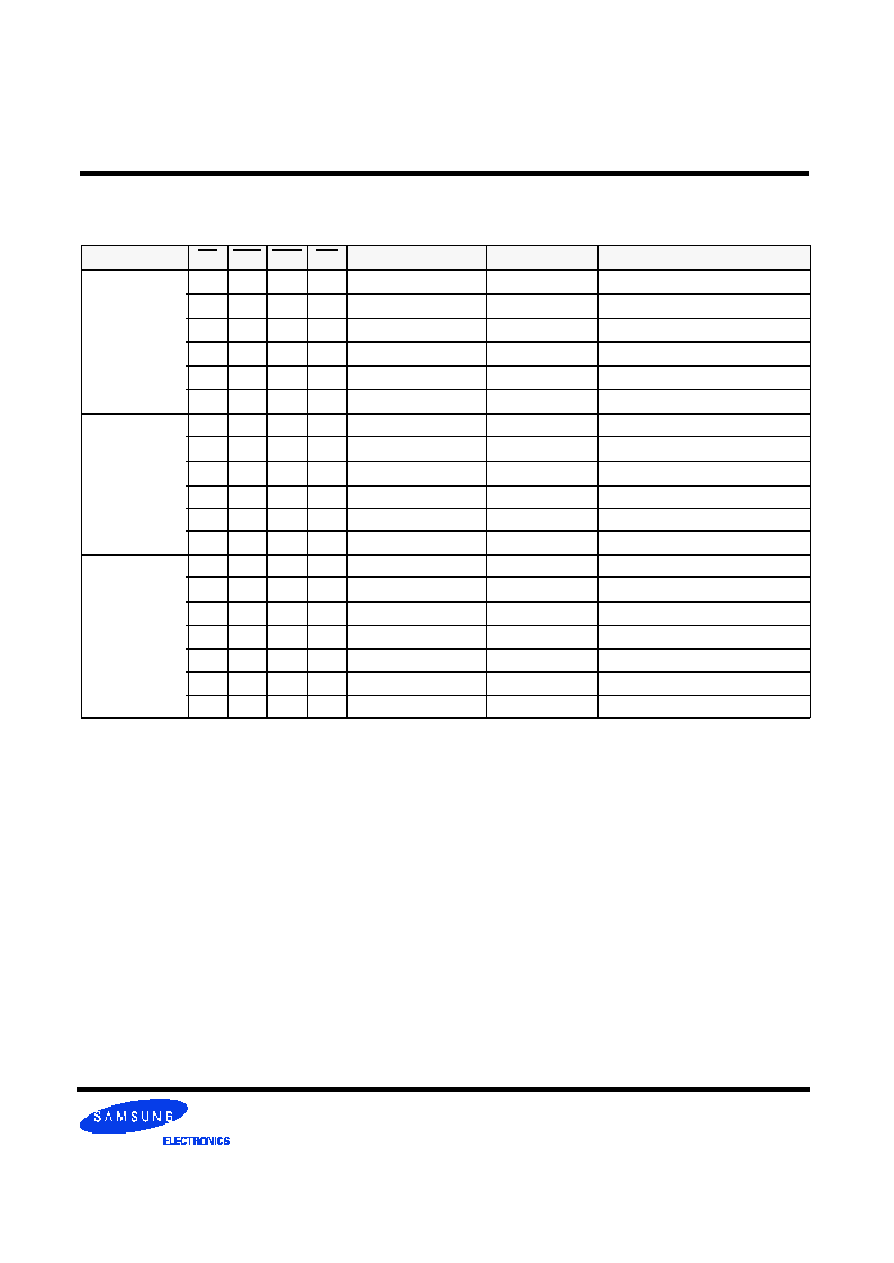
- 36 -
REV. 0.6 Oct. 21. 2002
128Mb D-die(x16) DDR SDRAM
Current State
CS
RAS CAS WE
Address
Command
Action
PRECHARG-
ING
(DURING tRP)
L
H
H
L
X
Burst Stop
ILLEGAL*2
L
H
L
X
BA, CA, A
10
READ/WRITE
ILLEGAL*2
L
L
H
H
BA, RA
Active
ILLEGAL*2
L
L
H
L
BA, A
10
PRE/PREA
NOP*4(Idle after
t
RP
)
L
L
L
H
X
Refresh
ILLEGAL
L
L
L
L
Op-Code, Mode-Add
MRS
ILLEGAL
ROW
ACTIVATING
(FROM ROW
ACTIVE TO
tRCD)
L
H
H
L
X
Burst Stop
ILLEGAL*2
L
H
L
X
BA, CA, A
10
READ/WRITE
ILLEGAL*2
L
L
H
H
BA, RA
Active
ILLEGAL*2
L
L
H
L
BA, A
10
PRE/PREA
ILLEGAL*2
L
L
L
H
X
Refresh
ILLEGAL
L
L
L
L
Op-Code, Mode-Add
MRS
ILLEGAL
WRITE
RECOVERING
(DURING tWR
OR tCDLR)
L
H
H
L
X
Burst Stop
ILLEGAL*2
L
H
L
H
BA, CA, A
10
READ
ILLEGAL*2
L
H
L
L
BA, CA, A
10
WRITE
WRITE
L
L
H
H
BA, RA
Active
ILLEGAL*2
L
L
H
L
BA, A
10
PRE/PREA
ILLEGAL*2
L
L
L
H
X
Refresh
ILLEGAL
L
L
L
L
Op-Code, Mode-Add MRS
ILLEGAL
Table 9-3. Functional truth table

- 37 -
REV. 0.6 Oct. 21. 2002
128Mb D-die(x16) DDR SDRAM
Current State
CS
RAS CAS WE
Address
Command
Action
RE-
FRESHING
L
H
H
L
X
Burst Stop
ILLEGAL
L
H
L
X
BA, CA, A
10
READ/WRITE
ILLEGAL
L
L
H
H
BA, RA
Active
ILLEGAL
L
L
H
L
BA, A
10
PRE/PREA
ILLEGAL
L
L
L
H
X
Refresh
ILLEGAL
L
L
L
L
Op-Code, Mode-Add
MRS
ILLEGAL
MODE
REGISTER
SETTING
L
H
H
L
X
Burst Stop
ILLEGAL
L
H
L
X
BA, CA, A
10
READ/WRITE
ILLEGAL
L
L
H
H
BA, RA
Active
ILLEGAL
L
L
H
L
BA, A
10
PRE/PREA
ILLEGAL
L
L
L
H
X
Refresh
ILLEGAL
L
L
L
L
Op-Code, Mode-Add
MRS
ILLEGAL
Table 9-4. Functional truth table

- 38 -
REV. 0.6 Oct. 21. 2002
128Mb D-die(x16) DDR SDRAM
ABBREVIATIONS :
H=High Level, L=Low level, X=Don
t Care
Note :
1. All entries assume that CKE was High during the preceding clock cycle and the current clock cycle.
2. ILLEGAL to bank in specified state ; function may be legal in the bank indicated by BA, depending on the state of that bank.
3. Must satisfy bus contention, bus turn around and write recovery requirements.
4. NOP to bank precharging or in idle sate. May precharge bank indicated by BA.
5. ILLEGAL if any bank is not idle.
6. Refer to "3.3.11 Read with Auto Precharge" in page 29 for detailed information.
7. Refer to "3.3.12 Write with Auto Precharge" in page 30 for detailed information.
8. CKE Low to High transition will re-enable CK, CK and other inputs asynchronously. A minimum setup time must be satisfied
before issuing any command other than EXIT.
9. Power-Down and Self-Refresh can be entered only from All Bank Idle state.
ILLEGAL = Device operation and/or data integrity are not guaranteed.
Current State
CKE
n-1
CKE
n
CS
RAS
CAS
WE
Add
Action
SELF-
REFRESHING
*8
L
H
H
X
X
X
X
Exit Self-Refresh
L
H
L
H
H
H
X
Exit Self-Refresh
L
H
L
H
H
L
X
ILLEGAL
L
H
L
H
L
X
X
ILLEGAL
L
H
L
L
X
X
X
ILLEGAL
L
L
X
X
X
X
X
NOPeration(Maintain Self-Refresh)
POWER
D O W N
L
H
X
X
X
X
X
Exit Power Down(Idle after
t
PDEX
)
L
L
X
X
X
X
X
NOPeration(Maintain Power Down)
ALL BANKS
IDLE
*9
H
H
X
X
X
X
X
Refer to Function True Table
H
L
L
L
L
H
X
Enter Self-Refresh
H
L
H
X
X
X
X
Enter Power Down
H
L
L
H
H
H
X
Enter Power Down
H
L
L
H
H
L
X
ILLEGAL
H
L
L
H
L
X
X
ILLEGAL
H
L
L
L
X
X
X
ILLEGAL
L
X
X
X
X
X
X
Refer to Current State=Power Down
ANY STATE
other than
listed above
H
H
X
X
X
X
X
Refer to Function Truth Table
Table 9-5. Functional truth table

- 39 -
REV. 0.6 Oct. 21. 2002
128Mb D-die(x16) DDR SDRAM
6. Absolute Maximum Rating
7. DC Operating Conditions & Specifications
7.1 DC Operating Conditions
Parameter
Symbol
Value
Unit
Voltage on any pin relative to V
SS
V
I N
, V
OUT
-0.5 ~ 3.6
V
Voltage on V
DD
& V
DDQ
supply relative to V
SS
V
DD
, V
DDQ
-1.0 ~ 3.6
V
Storage temperature
T
STG
-55 ~ +150
�
C
Power dissipation
P
D
1.5
W
Short circuit current
I
OS
50
mA
Note :
Permanent device damage may occur if ABSOLUTE MAXIMUM RATINGS are exceeded.
Functional operation should be restricted to recommend operation condition.
Exposure to higher than recommended voltage for extended periods of time could affect device reliability.
Recommended operating conditions(Voltage referenced to V
SS
=0V, T
A
=0 to 70
�
C)
Parameter
Symbol
Min
Max
Unit
Note
Supply voltage(for device with a nominal V
DD
of 2.5V)
V
DD
2.3
2.7
I/O Supply voltage
V
DDQ
2.3
2.7
V
I/O Reference voltage
V
REF
VDDQ/2-50mV
VDDQ/2+50mV
V
1
I/O Termination voltage(system)
V
T T
V
REF
-0.04
V
REF
+0.04
V
2
Input logic high voltage
V
IH
(DC)
V
REF
+0.15
V
DDQ
+0.3
V
4
Input logic low voltage
V
IL
(DC)
-0.3
V
REF
-0.15
V
4
Input Voltage Level, CK and CK inputs
V
IN
(DC)
-0.3
V
DDQ
+0.3
V
Input Differential Voltage, CK and CK inputs
V
ID
(DC)
0.3
V
DDQ
+0.6
V
3
Input crossing point voltage, CK and CK inputs
V
IX
(DC)
1.15
1.35
V
5
Input leakage current
I
I
-2
2
uA
Output leakage current
I
OZ
-5
5
uA
Output High Current(Normal strengh driver)
;V
OUT
= V
TT
+ 0.84V
I
O H
-16.8
mA
Output High Current(Normal strengh driver)
;V
OUT
= V
TT
- 0.84V
I
OL
16.8
mA
Output High Current(Half strengh driver)
;V
OUT
=
V
TT
+ 0.45V
I
O H
-9
mA
Output High Current(Half strengh driver)
;V
OUT
= V
TT
- 0.45V
I
OL
9
mA
Table 10. Absolute maximum ratings
Table 11. DC operating condition

- 40 -
REV. 0.6 Oct. 21. 2002
128Mb D-die(x16) DDR SDRAM
Notes 1. Includes
�
25mV margin for DC offset on V
REF
, and a combined total of
�
50mV margin for all AC noise and DC offset on V
REF
,
bandwidth limited to 20MHz. The DRAM must accommodate DRAM current spikes on V
REF
and internal DRAM noise coupled
TO V
REF
, both of which may result in V
REF
noise. V
REF
should be de-coupled with an inductance of
3nH.
2.V
TT
is not applied directly to the device. V
TT
is a system supply for signal termination resistors, is expected to be set equal to
V
REF
, and must track variations in the DC level of V
REF
3. V
ID
is the magnitude of the difference between the input level on CK and the input level on CK.
4. These parameters should be tested at the pin on actual components and may be checked at either the pin or the pad in
simulation. The AC and DC input specifications are relative to a VREF envelop that has been bandwidth limited to 200MHZ.
5. The value of V
IX
is expected to equal 0.5*V
DDQ
of the transmitting device and must track variations in the dc level of the same.
7.2 DDR SDRAM SPEC Items and Test Conditions
Conditions
Symbol
Operating current - One bank Active-Precharge;
tRC=tRCmin;
DQ,DM and DQS inputs changing twice per clock cycle;
address and control inputs changing once per clock cycle
IDD0
Operating current - One bank operation ; One bank open, BL=4, Reads
- Refer to the following page for detailed test condition
IDD1
Percharge power-down standby current; All banks idle; power - down mode;
CKE = <VIL(max); Vin = Vref for DQ,DQS and DM
IDD2P
Precharge Floating standby current; CS# > =VIH(min);All banks idle;
CKE > = VIH(min); Address and other control inputs changing once per clock cycle;
Vin = Vref for DQ,DQS and DM
IDD2F
Precharge Quiet standby current; CS# > = VIH(min); All banks idle;
CKE > = VIH(min);
Address and other control inputs stable with keeping >= VIH(min) or =<VIL(max);
Vin = Vref for DQ ,DQS and DM
IDD2Q
Active power - down standby current ; one bank active; power-down mode;
CKE=< VIL (max); Vin = Vref for DQ,DQS and DM
IDD3P
Active standby current; CS# >= VIH(min); CKE>=VIH(min);
one bank active; active - precharge; tRC=tRASmax;
DQ, DQS and DM inputs changing twice per clock cycle;
address and other control inputs changing once per clock cycle
IDD3N
Operating current - burst read; Burst length = 2; reads; continguous burst;
One bank active; address and control inputs changing once per clock cycle;
50% of data changing at every burst; lout = 0 m A
IDD4R
Operating current - burst write; Burst length = 2; writes; continuous burst;
One bank active address and control inputs changing once per clock cycle;
DQ, DM and DQS inputs changing twice
per clock cycle, 50% of input data changing at every burst
IDD4W
Auto refresh current; tRC = tRFC(min) - 8*tCK for DDR200 at 100Mhz,
10*tCK for DDR266A & DDR266B at 133Mhz and 12*tCK for DDR333; distributed refresh
IDD5
Self refresh current; CKE =< 0.2V; External clock should be on;
tCK = 100Mhz for DDR200, 133Mhz for DDR266A & DDR266B and 166Mhz for DDR333
IDD6
Orerating current - Four bank operation ; Four bank interleaving with BL=4
-Refer to the following page for detailed test condition
IDD7A

- 41 -
REV. 0.6 Oct. 21. 2002
128Mb D-die(x16) DDR SDRAM
Table 12. IDD SPEC Table
Symbol
K4H281638D-
TCB3
(DDR333)
K4H281638D-
TCA2
(DDR266A)
K4H281638D-
TCB0
(DDR266B)
K4H281638D-
TCA0
(DDR200)
Unit
Notes
IDD0
105
95
95
85
mA
IDD1
135
125
125
115
mA
IDD2P
3
3
3
2.5
mA
IDD2F
25
25
25
22
mA
IDD2Q
18
18
18
18
mA
IDD3P
35
35
35
28
mA
IDD3N
60
55
55
45
mA
IDD4R
190
172
172
150
mA
IDD4W
170
150
150
120
mA
IDD5
190
180
180
165
mA
IDD6
Normal
2
2
2
2
mA
Low power
1
1
1
1
mA
Optional
IDD7A
345
320
320
255
mA
7.3 IDD spec table
(V
DD
=2.7V, T
= 10
�
C
)
< Detailed test conditions for DDR SDRAM IDD1 & IDD7 >
IDD1 : Operating current: One bank operation
1. Typical Case : Vdd = 2.5V, T=25' C
2. Worst Case : Vdd = 2.7V, T= 10' C
3. Only one bank is accessed with tRC(min), Burst Mode, Address and Control inputs on NOP edge are changing once
per clock cycle. lout = 0mA
4. Timing patterns
- DDR200(100Mhz, CL=2) : tCK = 10ns, CL2, BL=4, tRCD = 2*tCK, tRAS = 5*tCK
Read : A0 N R0 N N P0 N A0 N - repeat the same timing with random address changing
*50% of data changing at every burst
- DDR266B(133Mhz, CL=2.5) : tCK = 7.5ns, CL=2.5, BL=4, tRCD = 3*tCK, tRC = 9*tCK, tRAS = 5*tCK
Read : A0 N N R0 N P0 N N N A0 N - repeat the same timing with random address changing
*50% of data changing at every burst
- DDR266A (133Mhz, CL=2) : tCK = 7.5ns, CL=2, BL=4, tRCD = 3*tCK, tRC = 9*tCK, tRAS = 5*tCK
Read : A0 N N R0 N P0 N N N A0 N - repeat the same timing with random address changing
*50% of data changing at every burst
- DDR333(166Mhz, CL=2.5) : tCK=6ns, CL=2.5, BL=4, tRCD=10*tCK, tRAS=7*tCK
Read : A0 N N R0 N P0 N N N A0 N - repeat the same timing with random address changing
*50% of data changing at every burst
Legend : A=Activate, R=Read, W=Write, P=Precharge, N=NOP

- 42 -
REV. 0.6 Oct. 21. 2002
128Mb D-die(x16) DDR SDRAM
8. AC Operating Conditions & Timming Specification
8.1 AC Operating Conditions
Parameter/Condition
Symbol
Min
Max
Unit
Note
Input High (Logic 1) Voltage, DQ, DQS and DM signals
VIH(AC)
VREF + 0.31
V
3
Input Low (Logic 0) Voltage, DQ, DQS and DM signals.
VIL(AC)
VREF - 0.31
V
3
Input Differential Voltage, CK and CK inputs
VID(AC)
0.7
VDDQ+0.6
V
1
Input Crossing Point Voltage, CK and CK inputs
VIX(AC)
0.5*VDDQ-0.2
0.5*VDDQ+0.2
V
2
Note 1. VID is the magnitude of the difference between the input level on CK and the input on CK.
2. The value of V
IX
is expected to equal 0.5*V
DDQ
of the transmitting device and must track variations in the DC level of the same.
3. These parameters should be tested at the pim on actual components and may be checked at either the pin or the pad in simula-
tion. the AC and DC input specificatims are refation to a Vref envelope that has been bandwidth limited 20MHz.
Table 13. AC operating conditions
I
DD7A
: Operating current: Four bank operation
1. Typical Case : Vdd = 2.5V, T=25' C
2. Worst Case : Vdd = 2.7V, T= 10' C
3. Four banks are being interleaved with tRC(min), Burst Mode, Address and Control inputs on NOP edge are not
changing. lout = 0mA
4. Timing patterns
- DDR200(100Mhz, CL=2) : tCK = 10ns, CL2, BL=4, tRRD = 2*tCK, tRCD= 3*tCK, Read with autoprecharge
Read : A0 N A1 R0 A2 R1 A3 R2 A0 R3 A1 R0 - repeat the same timing with random address changing
*100% of data changing at every burst
- DDR266B(133Mhz, CL=2.5) : tCK = 7.5ns, CL=2.5, BL=4, tRRD = 2*tCK, tRCD = 3*tCK
Read with autoprecharge
Read : A0 N A1 R0 A2 R1 A3 R2 N R3 A0 N A1 R0 - repeat the same timing with random address changing
*100% of data changing at every burst
- DDR266A (133Mhz, CL=2) : tCK = 7.5ns, CL2=2, BL=4, tRRD = 2*tCK, tRCD = 3*tCK,Read with autoprecharge
Read : A0 N A1 R0 A2 R1 A3 R2 N R3 A0 N A1 R0 - repeat the same timing with random address changing
*100% of data changing at every burst
-DDR333(166Mhz,CL=2.5) : tCK=6ns, CL=2.5, BL=4, tRRD=2*tCK, tRCD=3*tCK,Read with autoprecharge
Read : A0 N A1 R0 A2 R1 A3 R2 N R3 A0 N A1 R0 - repeat the same timing with random address changing
*100% of data changing at every burst
Legend : A=Activate, R=Read, W=Write, P=Precharge, N=NOP
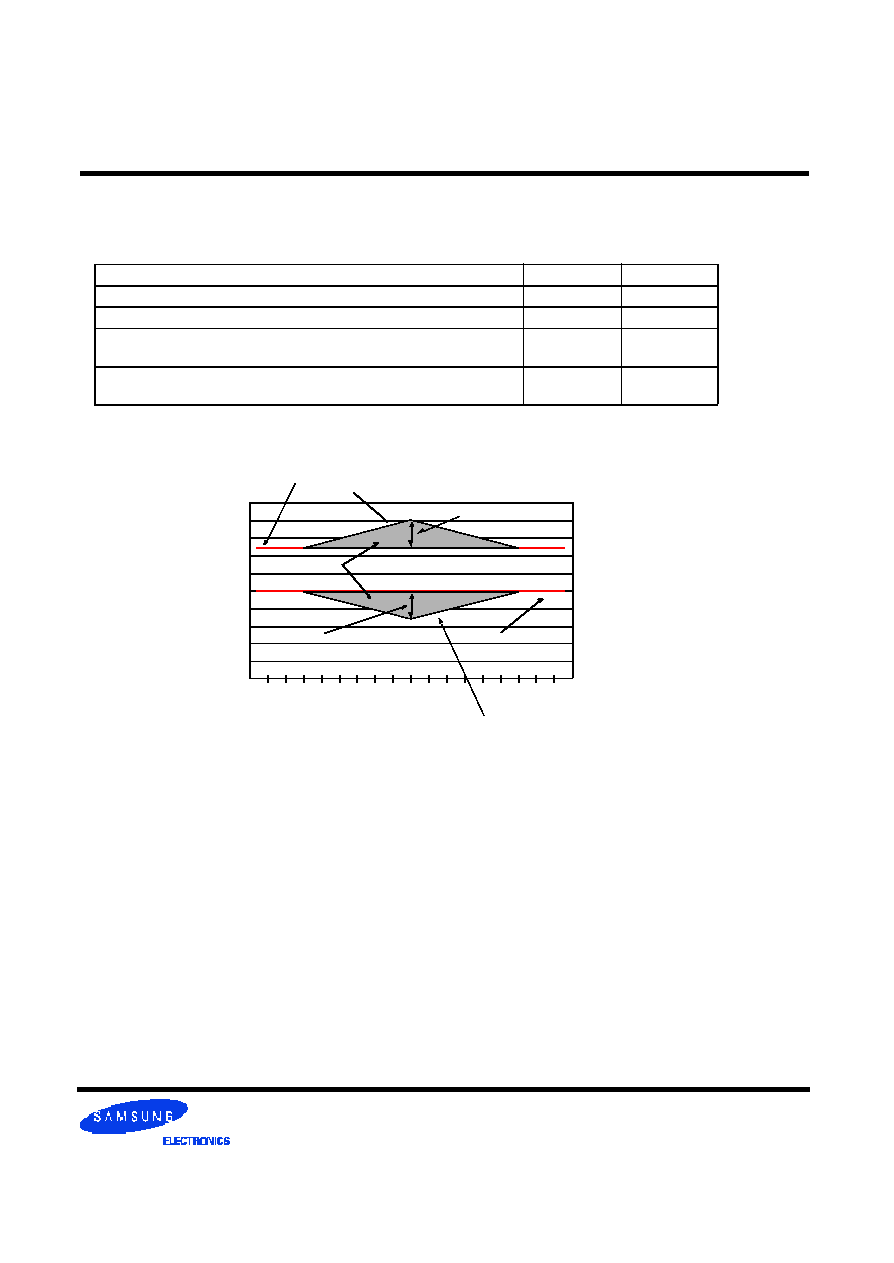
- 43 -
REV. 0.6 Oct. 21. 2002
128Mb D-die(x16) DDR SDRAM
8.2 AC Overshoot/Undershoot specification
Parameter
Specification
Notes
Maximum peak amplitude allowed for overshoot (See Figure 1):
1.6 V
1,2,3
Maximum peak amplitude allowed for undershoot (See Figure 1):
1.6 V
1,2,3
The area between the overshoot signal and VDD must be less than or
equal to (See Figure 1):
4.5 V-ns
1,2,3
The area between the undershoot signal and GND must be less than or
equal to (See Figure 1):
4.5 V-ns
1,2,3
5
4
3
2
1
0
-1
-2
-3
-4
-5
0
0.5
0.6875
1.0
1.5
2.0
2.5
3.0
3.5
4.0
4.5
5.0
5.5
6.0
6.3125
6.5
7.0
VDD
Overshoot
Maximum Amplitude = 1.6V
Area = 4.5V-ns
Maximum Amplitude = 1.6V
undershoot
GND
V
o
l
t
s
(
V
)
Tims(ns)
8.2.1 Overshoot/Undershoot specification for Address and Control Pins
Table 14. Overshoot/Undershoot specification for Address and Control Pins
Figure 24. AC overshoot/Undershoot Definition
Notes:
1. This specification is intended for only DDR200, DDR266A and DDR266B devices.
2. This specification is intended for only devices with NO clamp protection
3. This compliance is to be verified by design only.

- 44 -
REV. 0.6 Oct. 21. 2002
128Mb D-die(x16) DDR SDRAM
8.2.2 Overshoot/Undershoot specification for Data Pins
Parameter
Specification
Notes
Maximum peak amplitude allowed for overshoot (See Figure 2):
1.2 V
1,2,3
Maximum peak amplitude allowed for undershoot (See Figure 2):
1.2 V
1,2,3
The area between the overshoot signal and VDD must be less than or
equal to (See Figure 2):
2.5 V-ns
1,2,3
The area between the undershoot signal and GND must be less than or
equal to (See Figure 2):
2.5 V-ns
1,2,3
5
4
3
2
1
0
-1
-2
-3
-4
-5
0 0.5 1.0 1.42 1.5 2.0 2.5 3.0 3.5 4.0 4.5 5.0 5.5 5.68 6.0 6.5 7.0
VDDQ
Overshoot
Maximum Amplitude = 1.2V
Area = 2.5V-ns
Maximum Amplitude = 1.2V
undershoot
GND
V
o
l
t
s
(
V
)
Notes:
1. This specification is intended for only DDR200, DDR266A and DDR266B devices.
2. This specification is intended for only devices with NO clamp protection
3. This compliance is to be verified by design only.
Tims(ns)
Table 15. Overshoot/Undershoot specification for Data Pins
Figure 25. AC overshoot/Undershoot Definition
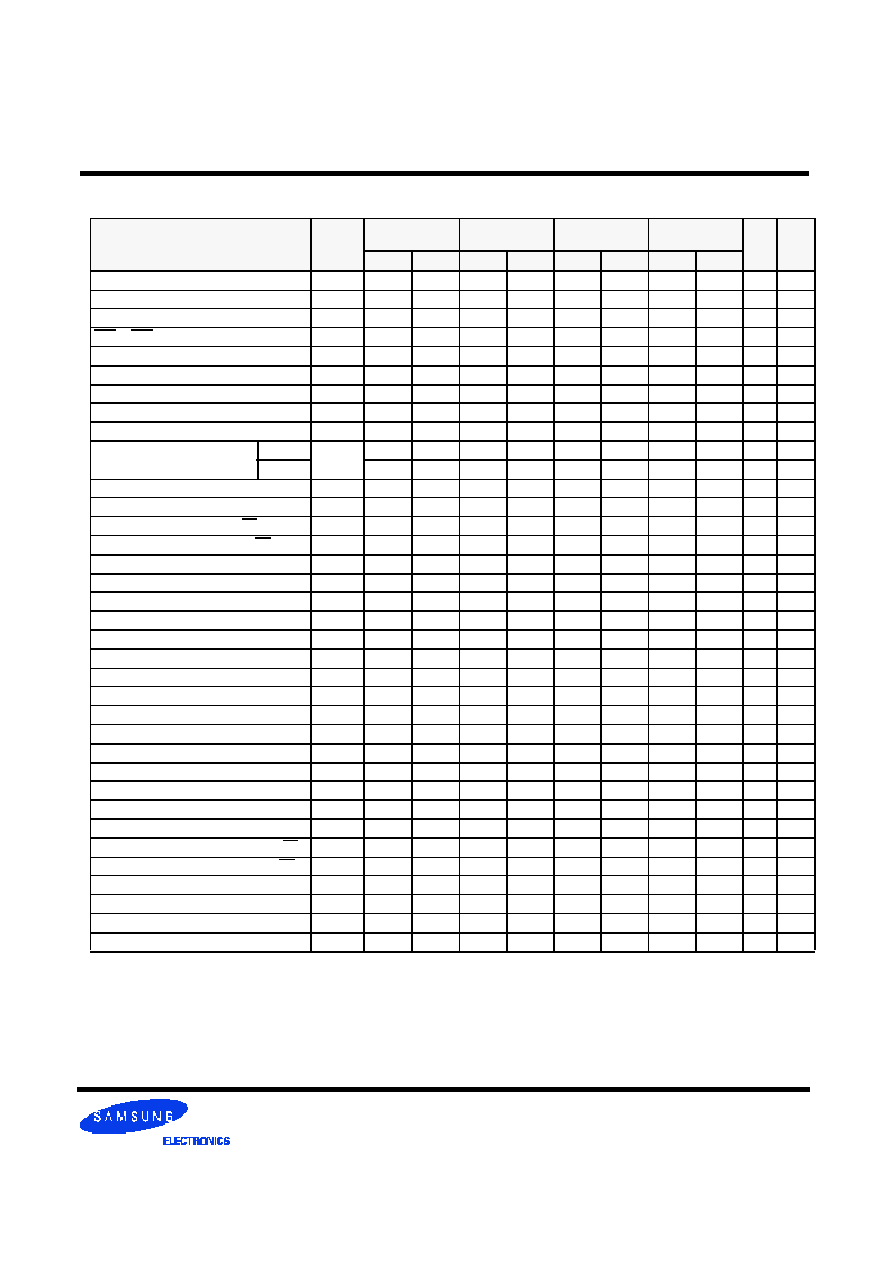
- 45 -
REV. 0.6 Oct. 21. 2002
128Mb D-die(x16) DDR SDRAM
AC Timming Parameters & Specifications
Parameter
Symbol
-TCB3
(DDR333)
-TCA2
(DDR266A)
-TCB0
(DDR266B)
-TCA0
(DDR200)
Unit Note
Min
Max
Min
Max
Min
Max
Min
Max
Row cycle time
tRC
60
65
65
70
ns
Refresh row cycle time
tRFC
72
75
75
80
ns
Row active time
tRAS
42
70K
45
120K
45
120K
48
120K
ns
RAS to CAS delay
tRCD
18
20
20
20
ns
Row precharge time
tRP
18
20
20
20
ns
Row active to Row active delay
tRRD
12
15
15
15
ns
Write recovery time
tWR
15
15
15
15
ns
Last data in to Read command
tWTR
1
1
1
1
tCK
Col. address to Col. address delay
tCCD
1
1
1
1
tCK
Clock cycle time
CL=2.0
tCK
7.5
12
7.5
12
10
12
10
12
ns
5
CL=2.5
6
12
7.5
12
7.5
12
ns
5
Clock high level width
tCH
0.45
0.55
0.45
0.55
0.45
0.55
0.45
0.55
tCK
Clock low level width
tCL
0.45
0.55
0.45
0.55
0.45
0.55
0.45
0.55
tCK
DQS-out access time from CK/CK
tDQSCK
-0.6
+0.6
-0.75
+0.75
-0.75
+0.75
-0.8
+0.8
ns
Output data access time from CK/CK
tAC
-0.7
+0.7
-0.75
+0.75
-0.75
+0.75
-0.8
+0.8
ns
Data strobe edge to ouput data edge
tDQSQ
-
0.45
-
0.5
-
0.5
-
0.6
ns
5
Read Preamble
tRPRE
0.9
1.1
0.9
1.1
0.9
1.1
0.9
1.1
tCK
Read Postamble
tRPST
0.4
0.6
0.4
0.6
0.4
0.6
0.4
0.6
tCK
CK to valid DQS-in
tDQSS
0.75
1.25
0.75
1.25
0.75
1.25
0.75
1.25
tCK
DQS-in setup time
tWPRES
0
0
0
0
ns
2
DQS-in hold time
tWPRE
0.25
0.25
0.25
0.25
tCK
DQS falling edge to CK rising-setup time
tDSS
0.2
0.2
0.2
0.2
tCK
DQS falling edge from CK rising-hold time
tDSH
0.2
0.2
0.2
0.2
tCK
DQS-in high level width
tDQSH
0.35
0.35
0.35
0.35
tCK
DQS-in low level width
tDQSL
0.35
0.35
0.35
0.35
tCK
DQS-in cycle time
tDSC
0.9
1.1
0.9
1.1
0.9
1.1
0.9
1.1
tCK
Address and Control Input setup time(fast)
tIS
0.75
0.9
0.9
1.1
ns
6
Address and Control Input hold time(fast)
tIH
0.75
0.9
0.9
1.1
ns
6
Address and Control Input setup time(slow)
tIS
0.8
1.0
1.0
1.1
ns
6
Address and Control Input hold time(slow)
tIH
0.8
1.0
1.0
1.1
ns
6
Data-out high impedence time from CK/CK
tHZ
-0.7
+0.7
-0.75
+0.75
-0.75
+0.75
-0.8
+0.8
ns
Data-out low impedence time from CK/CK
tLZ
-0.7
+0.7
-0.75
+0.75
-0.75
+0.75
-0.8
+0.8
ns
Input Slew Rate(for input only pins)
tSL(I)
0.5
0.5
0.5
0.5
V/ns
6
Input Slew Rate(for I/O pins)
tSL(IO)
0.5
0.5
0.5
0.5
V/ns
7
Output Slew Rate(x4,x8)
tSL(O)
1.0
4.5
1.0
4.5
1.0
4.5
1.0
4.5
V/ns
10
Output Slew Rate Matching Ratio(rise to fall)
tSLMR
0.67
1.5
0.67
1.5
0.67
1.5
0.67
1.5

- 46 -
REV. 0.6 Oct. 21. 2002
128Mb D-die(x16) DDR SDRAM
1. Maximum burst refresh cycle : 8
2. The specific requirement is that DQS be valid(High or Low) on or before this CK edge. The case shown(DQS going from
High_Z to logic Low) applies when no writes were previously in progress on the bus. If a previous write was in progress,
DQS could be High at this time, depending on tDQSS.
3. The maximum limit for this parameter is not a device limit. The device will operate with a great value for this parameter,
but system performance (bus turnaround) will degrade accordingly.
4. A write command can be applied with t
RCD
satisfied after this command.
5. For registered DIMMs, t
CL
and t
CH
are
45% of the period including both the half period jitter (t
JIT(HP)
) of the PLL and the half period
jitter due to crosstalk (t
JIT
(crosstalk)
) on the DIMM.
6. Input Setup/Hold Slew Rate Derating
This derating table is used to increase t
IS
/t
IH
in the case where the input slew rate is below 0.5V/ns. Input setup/hold slew rate
based on the lesser of AC-AC slew rate and DC-DC slew rate.
7. I/O Setup/Hold Slew Rate Derating
This derating table is used to increase t
D S
/t
DH
in the case where the I/O slew rate is below 0.5V/ns. I/O setup/hold slew rate
based on the lesser of AC-AC slew rate and DC-DC slew rate.
Parameter
Symbol
-TCB3
(DDR333)
-TCA2
(DDR266A)
-TCB0
(DDR266B)
-TCA0
(DDR200)
Unit Note
Min
Max
Min
Max
Min
Max
Min
Max
Mode register set cycle time
tMRD
12
15
15
16
ns
DQ & DM setup time to DQS
tDS
0.45
0.5
0.5
0.6
ns
7,8,9
DQ & DM hold time to DQS
tDH
0.45
0.5
0.5
0.6
ns
7,8,9
Control & Address input pulse width
tIPW
2.2
2.2
2.2
2.5
ns
DQ & DM input pulse width
tDIPW
1.75
1.75
1.75
2
ns
Power down exit time
tPDEX
6
7.5
7.5
10
ns
Exit self refresh to non-Read command
tXSNR
75
75
75
80
ns
4
Exit self refresh to read command
tXSRD
200
200
200
200
tCK
Refresh interval time
tREFI
15.6
15.6
15.6
15.6
us
1
Output DQS valid window
tQH
tHP
-tQHS
-
tHP
-tQHS
-
tHP
-tQHS
-
tHP
-tQHS
-
ns
5
Clock half period
tHP
tCLmin
or tCHmin
-
tCLmin
or tCHmin
-
tCLmin
or tCHmin
-
tCLmin
or tCHmin
-
ns
Data hold skew factor
tQHS
0.55
0.75
0.75
0.8
ns
DQS write postamble time
tWPST
0.4
0.6
0.4
0.6
0.4
0.6
0.4
0.6
tCK
3
Active to Read with Auto precharge
command
tRAP
18
20
20
20
Autoprecharge write recovery +
Precharge time
tDAL
(tWR/tCK)
+
(tRP/tCK)
(tWR/tCK)
+
(tRP/tCK)
(tWR/tCK)
+
(tRP/tCK)
(tWR/tCK)
+
(tRP/tCK)
tCK
11
Input Setup/Hold Slew Rate
tIS
tIH
(V/ns)
(ps)
(ps)
0.5
0
0
0.4
+50
+50
0.3
+100
+100
I/O Setup/Hold Slew Rate
tDS
tDH
(V/ns)
(ps)
(ps)
0.5
0
0
0.4
+75
+75
0.3
+150
+150
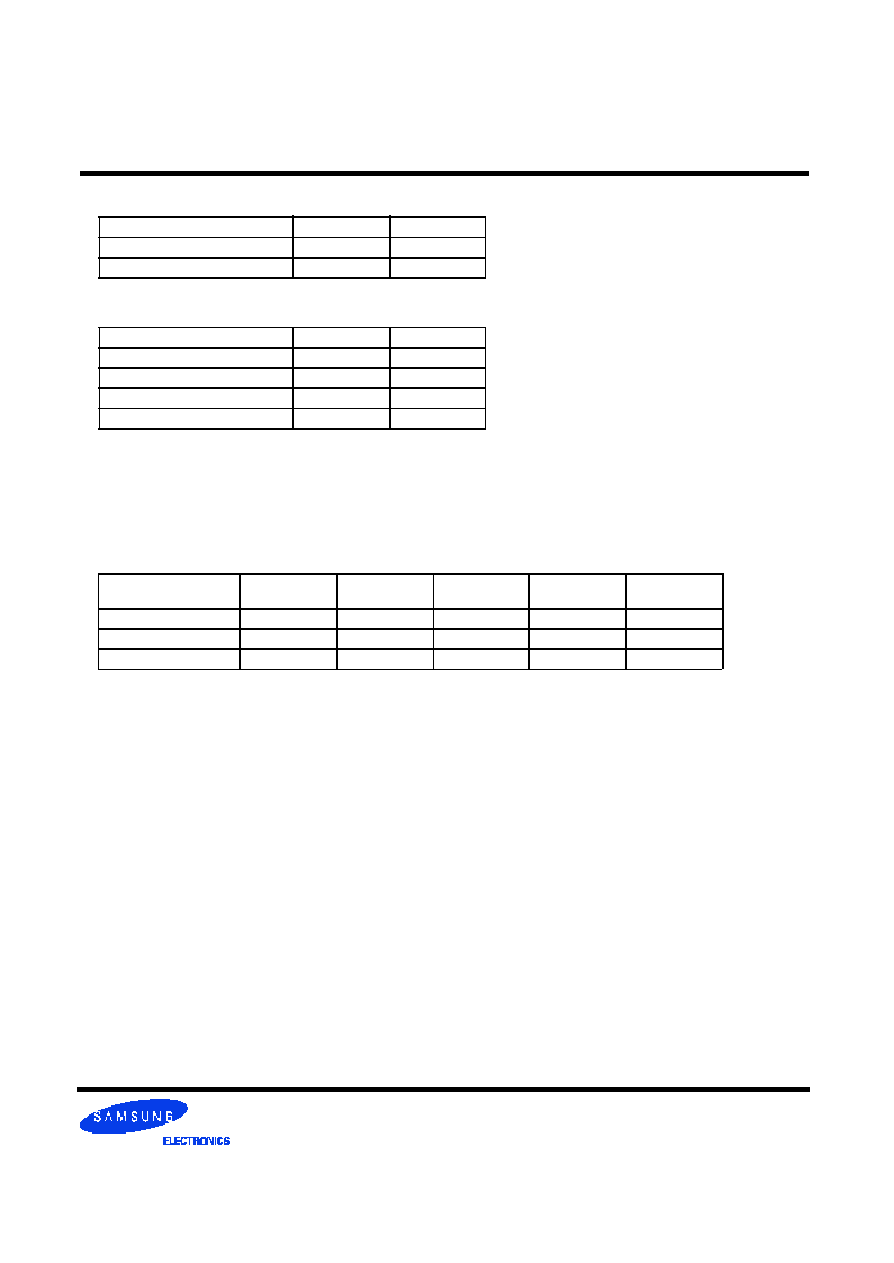
- 47 -
REV. 0.6 Oct. 21. 2002
128Mb D-die(x16) DDR SDRAM
8. I/O Setup/Hold Plateau Derating
This derating table is used to increase tDS/tDH in the case where the input level is flat below VREF
�
310mV for a duration of
up to 2ns.
9. I/O Delta Rise/Fall Rate(1/slew-rate) Derating
This derating table is used to increase t
DS
/t
DH
in the case where the DQ and DQS slew rates differ. The Delta Rise/Fall Rate
is calated as 1/SlewRate1-1/SlewRate2. For example, if slew rate 1 = 5V/ns and slew rate 2 =.4V/ns then the Delta Rise/Fall
Rate =-0/5ns/V. Input S/H slew rate based on larger of AC-AC delta rise/fall rate and DC-DC delta rise/fall rate.
10. This parameter is fir system simulation purpose. It is guranteed by design.
11. For each of the terms, if not already an integer, round to the next highest integer. tCK is actual to the system clock cyc le time.
I/O Input Level
tDS
tDH
(mV)
(ps)
(ps)
�
280
+50
+50
Delta Rise/Fall Rate
tDS
tDH
(ns/V)
(ps)
(ps)
0
0
0
�
0.25
+50
+50
�
0.5
+100
+100
The following table specifies derating values for the specifications listed if the single-ended clock skew rate is less than 1.0V/ns.
CK slew rate
(Single ended)
tIH/tIS
(ps)
tDSS/tDSH
(ps)
tAC/tDQSCK
(ps)
tLZ(min)
(ps)
tHZ(max)
(ps)
1.0V/ns
0
0
0
0
0
0.75V/ns
+50
+50
+50
-50
+50
0.5V/ns
+100
+100
+100
-100
+100
<Reference>
Table 16. AC timing parameter and specifications

- 48 -
REV. 0.6 Oct. 21. 2002
128Mb D-die(x16) DDR SDRAM
9. AC Operating Test Conditions
(V
DD
=2.5V, V
DDQ
=2.5V, T
A
= 0 to 70
�
C)
Parameter
Value
Unit
Note
Input reference voltage for Clock
0.5 * V
DDQ
V
Input signal maximum peak swing
1.5
V
Input Levels(V
IH
/V
IL
)
V
REF
+0.31/V
REF
-0.31
V
Input timing measurement reference level
V
REF
V
Output timing measurement reference level
V
tt
V
Output load condition
See Load Circuit
10. Input/Output Capacitance
(V
DD
=2.5, V
DDQ
=2.5V, T
A
= 25
�
C
,
f=1MHz)
Parameter
Symbol
Min
Max
Delta Cap(max)
Unit
Input capacitance
(A
0
~ A
11
, BA
0
~ BA
1,
CKE, CS, RAS,CAS, WE)
C
IN1
2
3.0
0.5
pF
Input capacitance(
CK, CK )
C
IN2
2
3.0
0.25
pF
Data & DQS input/output capacitance
C
OUT
4.0
5.0
0.5
pF
Input capacitance(DM)
C
IN3
4.0
5.0
pF
Table 17. AC operating test conditions
Table 18. Input/output capacitance
Figure 26. Output Load Circuit (SSTL_2)
Output
Z0=50
C
LOAD
=30pF
V
REF
=0.5*V
DDQ
R
T
=50
V
tt
=0.5*V
DDQ
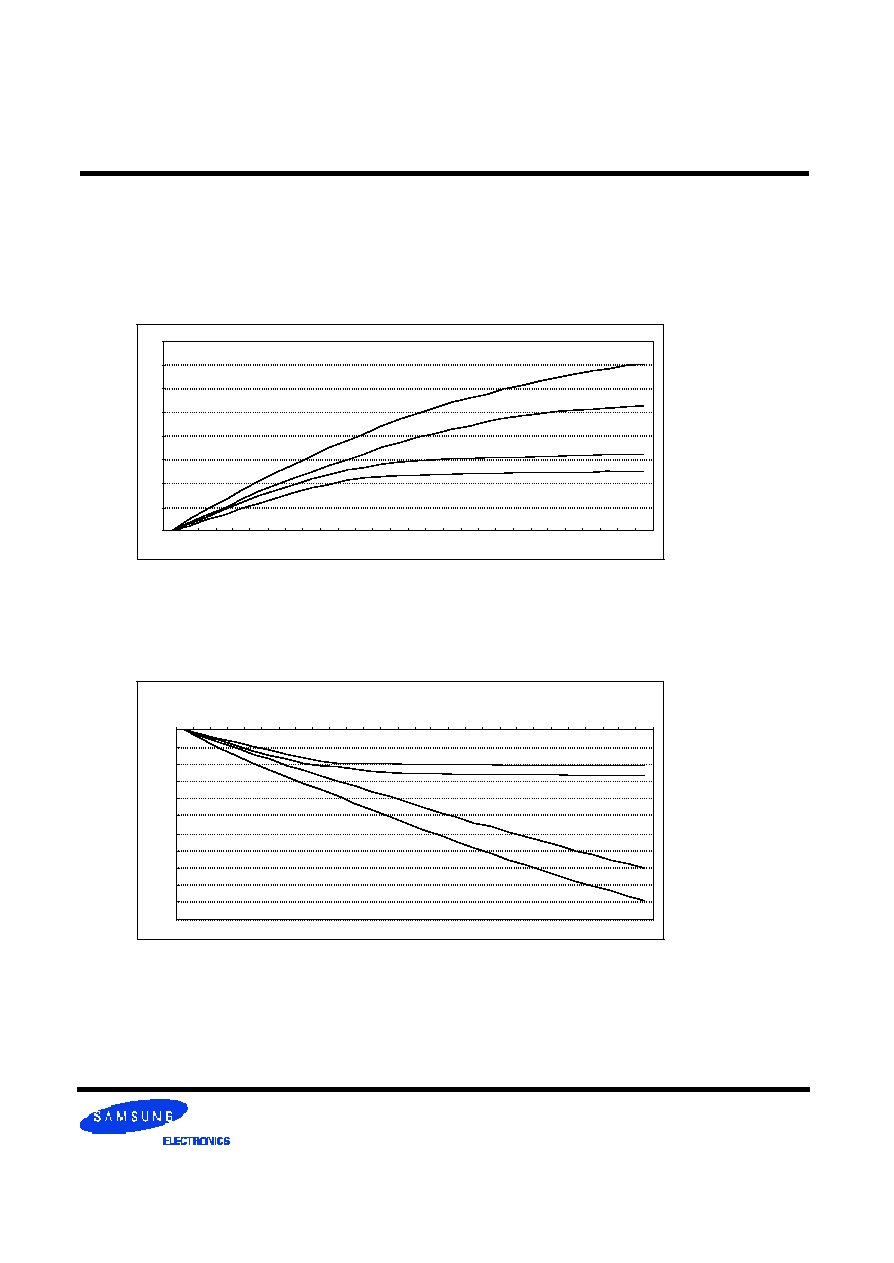
- 49 -
REV. 0.6 Oct. 21. 2002
128Mb D-die(x16) DDR SDRAM
11. IBIS: I/V Characteristics for Input and Output Buffers
Figure 27. I/V characteristics for input/output buffers:Pull up(above) and pull down(below)
11.1 Normal strength driver
1. The full variation in driver pulldown current from minimum to maximum process, temperature, and voltage will lie within the outer
bounding lines of the V-I curve of Figure a.
2. The full variation in driver pulldown current from minimum to maximum process, temperature and voltage will lie within the outer
bounding lines the of the V-I curve of Figure a.
3. The full variation in driver pullup current from minimum to maximun process, temperature, and voltage will lie within the outer
bounding lines of the V-I curve of Figure b.
4. The variation in the driver pullup current at nominal temperature and voltage is expected, but not guaranteed, to lie within the
inner boungding lines of the V-I curve of Figure b as
5. The full variation in the ratio of the maximum to minimum pullup and pulldown current will not exceed 1.7, for device drain to source
voltage from 0 to VDDQ/2
6. The Full variation in the ratio of the nominal pullup to pulldown current should be unity �10%, for device drain to source voltages
from 0 to VDDQ/2
Maximum
Typical High
Minumum
Vout(V)
I
o
u
t
(
m
A
)
-220
-200
-180
-160
-140
-120
-100
-80
-60
-40
-20
0
0.0
1.0
2.0
Minimum
Typical Low
Typical High
Maximum
0
20
40
60
80
100
120
140
160
0.0
0.5
1.0
1.5
2.0
2.5
I
o
u
t
(
m
A
)
Typical Low
Vout(V)

- 50 -
REV. 0.6 Oct. 21. 2002
128Mb D-die(x16) DDR SDRAM
Table 19. Pull down and pull up current values
Temperature (Tambient)
Typical 25
�
C
Minimum 70
�
C
Maximum 0
�
C
Vdd/Vddq
Typical
2.5V
Minimum 2.3V
Maximum 2.7V
The above characteristics are specified under best, worst and normal process variation/conditions
Pulldown Current (mA)
pullup Current (mA)
Voltage
(V)
Typical
Low
Typical
High
Minimum
Maximum
Typical
Low
Typical
High
Minimum
Maximum
0.1
6.0
6.8
4.6
9.6
-6.1
-7.6
-4.6
-10.0
0.2
12.2
13.5
9.2
18.2
-12.2
-14.5
-9.2
-20.0
0.3
18.1
20.1
13.8
26.0
-18.1
-21.2
-13.8
-29.8
0.4
24.1
26.6
18.4
33.9
-24.0
-27.7
-18.4
-38.8
0.5
29.8
33.0
23.0
41.8
-29.8
-34.1
-23.0
-46.8
0.6
34.6
39.1
27.7
49.4
-34.3
-40.5
-27.7
-54.4
0.7
39.4
44.2
32.2
56.8
-38.1
-46.9
-32.2
-61.8
0.8
43.7
49.8
36.8
63.2
-41.1
-53.1
-36.0
-69.5
0.9
47.5
55.2
39.6
69.9
-41.8
-59.4
-38.2
-77.3
1.0
51.3
60.3
42.6
76.3
-46.0
-65.5
-38.7
-85.2
1.1
54.1
65.2
44.8
82.5
-47.8
-71.6
-39.0
-93.0
1.2
56.2
69.9
46.2
88.3
-49.2
-77.6
-39.2
-100.6
1.3
57.9
74.2
47.1
93.8
-50.0
-83.6
-39.4
-108.1
1.4
59.3
78.4
47.4
99.1
-50.5
-89.7
-39.6
-115.5
1.5
60.1
82.3
47.7
103.8
-50.7
-95.5
-39.9
-123.0
1.6
60.5
85.9
48.0
108.4
-51.0
-101.3
-40.1
-130.4
1.7
61.0
89.1
48.4
112.1
-51.1
-107.1
-40.2
-136.7
1.8
61.5
92.2
48.9
115.9
-51.3
-112.4
-40.3
-144.2
1.9
62.0
95.3
49.1
119.6
-51.5
-118.7
-40.4
-150.5
2.0
62.5
97.2
49.4
123.3
-51.6
-124.0
-40.5
-156.9
2.1
62.9
99.1
49.6
126.5
-51.8
-129.3
-40.6
-163.2
2.2
63.3
100.9
49.8
129.5
-52.0
-134.6
-40.7
-169.6
2.3
63.8
101.9
49.9
132.4
-52.2
-139.9
-40.8
-176.0
2.4
64.1
102.8
50.0
135.0
-52.3
-145.2
-40.9
-181.3
2.5
64.6
103.8
50.2
137.3
-52.5
-150.5
-41.0
-187.6
2.6
64.8
104.6
50.4
139.2
-52.7
-155.3
-41.1
-192.9
2.7
65.0
105.4
50.5
140.8
-52.8
-160.1
-41.2
-198.2

- 51 -
REV. 0.6 Oct. 21. 2002
128Mb D-die(x16) DDR SDRAM
Figure 28. I/V characteristics for input/output buffers:Pull up(above) and pull down(below)
11.2 Weak strength driver
5. The full variation in the ratio of the maximum to minimum pullup and pulldown current will not exceed 1.7, for device drain to source
voltage from 0 to VDDQ/2
6. The Full variation in the ratio of the nominal pullup to pulldown current should be unity �10%, for device drain to source voltages
from 0 to VDDQ/2
Maximum
Typical High
Minumum
Vout(V)
I
o
u
t
(
m
A
)
-90
-80
-70
-60
-50
-40
-30
-20
-10
0
0.0
0.5
1.0
1.5
2.0
2.5
I
o
u
t
(
m
A
)
Minimum
Typical Low
Typical High
Maximum
0
10
20
30
40
50
60
70
80
90
0.0
0.5
1.0
1.5
2.0
2.5
I
o
u
t
(
m
A
)
Typical Low
1. The nominal pulldown V-I curve for DDR SDRAM devices will be within the inner bounding lines of the V-I curve of Figure a.
2. The full variation in driver pulldown current from minimum to maximum process, temperature and voltage will lie within the outer
bounding lines the of the V-I curve of Figure a.
3. Thenominal pullup V-I curve for DDR SDRAM devices will be within the inner bounding lines of the V-I curve of below Figure b.
4. The Full variation in driver pullup current from minimum to maximum process, temperature and voltage will lie within the outer
bounding lines of the V-I curve of Figrue b.
Vout(V)

- 52 -
REV. 0.6 Oct. 21. 2002
128Mb D-die(x16) DDR SDRAM
Temperature (Tambient)
Typical 25
�
C
Minimum 70
�
C
Maximum 0
�
C
Vdd/Vddq
Typical
2.5V
Minimum 2.3V
Maximum 2.7V
The above characteristics are specified under best, worst and normal process variation/conditions
Pulldown Current (mA)
pullup Current (mA)
Voltage
(V)
Typical
Low
Typical
High
Minimum
Maximum
Typical
Low
Typical
High
Minimum
Maximum
0.1
3.4
3.8
2.6
5.0
-3.5
-4.3
-2.6
-5.0
0.2
6.9
7.6
5.2
9.9
-6.9
-8.2
-5.2
-9.9
0.3
10.3
11.4
7.8
14.6
-10.3
-12.0
-7.8
-14.6
0.4
13.6
15.1
10.4
19.2
-13.6
-15.7
-10.4
-19.2
0.5
16.9
18.7
13.0
23.6
-16.9
-19.3
-13.0
-23.6
0.6
19.6
22.1
15.7
28.0
-19.4
-22.9
-15.7
-28.0
0.7
22.3
25.0
18.2
32.2
-21.5
-26.5
-18.2
-32.2
0.8
24.7
28.2
20.8
35.8
-23.3
-30.1
-20.4
-35.8
0.9
26.9
31.3
22.4
39.5
-24.8
-33.6
-21.6
-39.5
1.0
29.0
34.1
24.1
43.2
-26.0
-37.1
-21.9
-43.2
1.1
30.6
36.9
25.4
46.7
-27.1
-40.3
-22.1
-46.7
1.2
31.8
39.5
26.2
50.0
-27.8
-43.1
-22.2
-50.0
1.3
32.8
42.0
26.6
53.1
-28.3
-45.8
-22.3
-53.1
1.4
33.5
44.4
26.8
56.1
-28.6
-48.4
-22.4
-56.1
1.5
34.0
46.6
27.0
58.7
-28.7
-50.7
-22.6
-58.7
1.6
34.3
48.6
27.2
61.4
-28.9
-52.9
-22.7
-61.4
1.7
34.5
50.5
27.4
63.5
-28.9
-55.0
-22.7
-63.5
1.8
34.8
52.2
27.7
65.6
-29.0
-56.8
-22.8
-65.6
1.9
35.1
53.9
27.8
67.7
-29.2
-58.7
-22.9
-67.7
2.0
35.4
55.0
28.0
69.8
-29.2
-60.0
-22.9
-69.8
2.1
35.6
56.1
28.1
71.6
-29.3
-61.2
-23.0
-71.6
2.2
35.8
57.1
28.2
73.3
-29.5
-62.4
-23.0
-73.3
2.3
36.1
57.7
28.3
74.9
-29.5
-63.1
-23.1
-74.9
2.4
36.3
58.2
28.3
76.4
-29.6
-63.8
-23.2
-76.4
2.5
36.5
58.7
28.4
77.7
-29.7
-64.4
-23.2
-77.7
2.6
36.7
59.2
28.5
78.8
-29.8
-65.1
-23.3
-78.8
2.7
36.8
59.6
28.6
79.7
-29.9
-65.8
-23.3
-79.7
Table 20. Pull down and pull up current values



















































